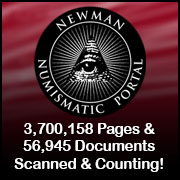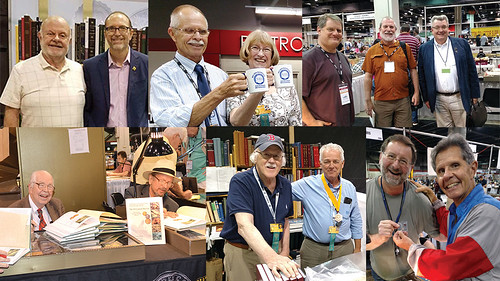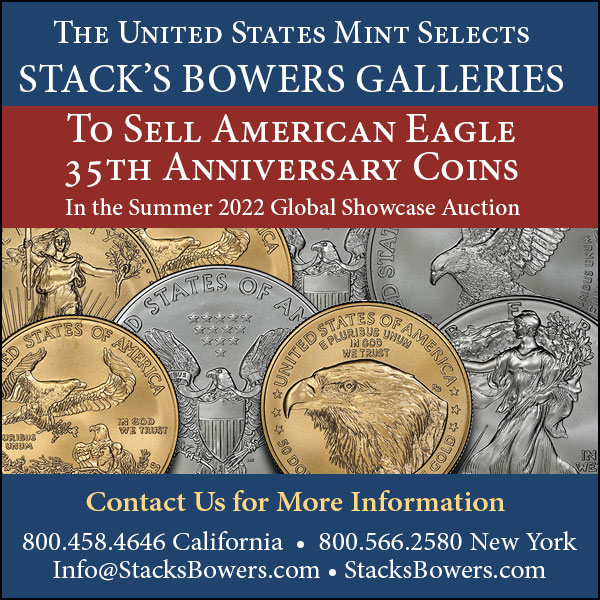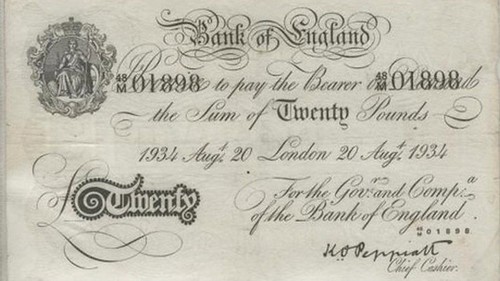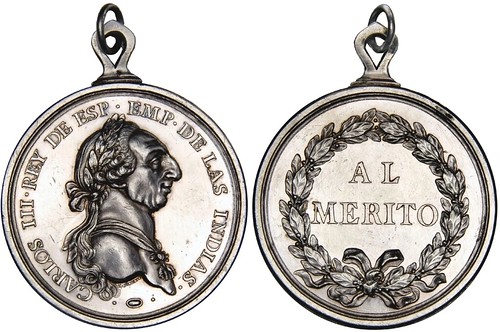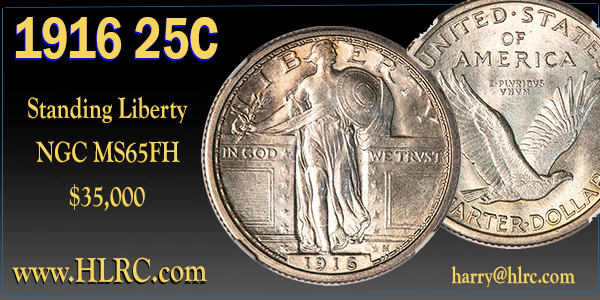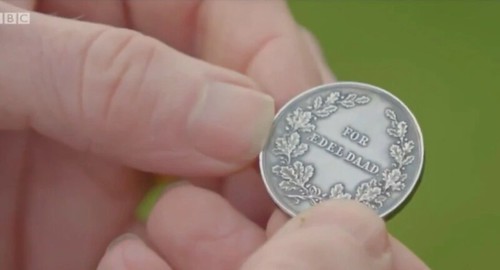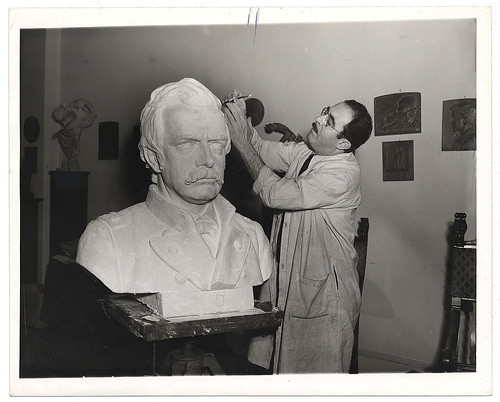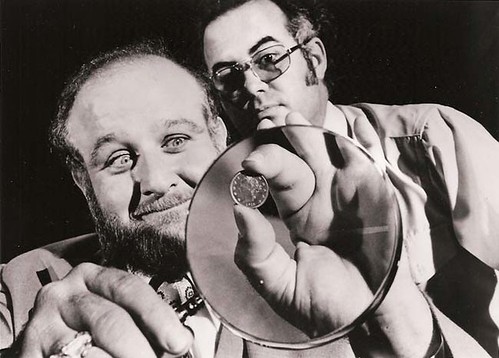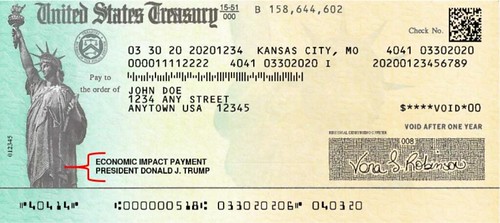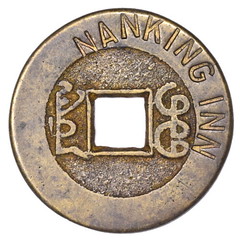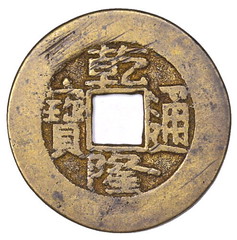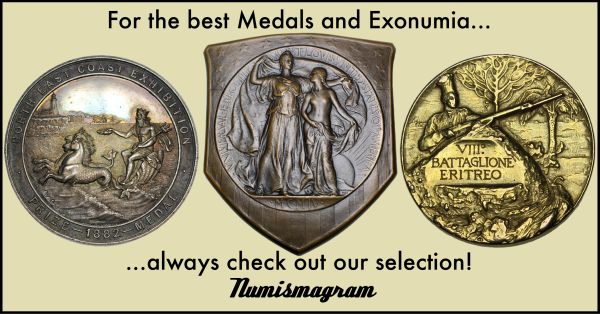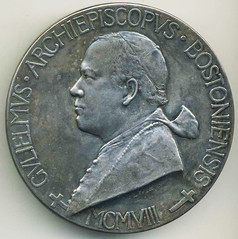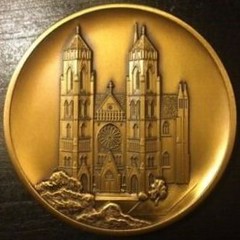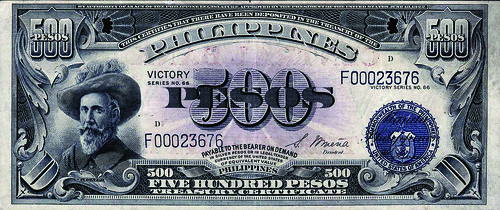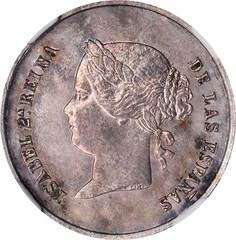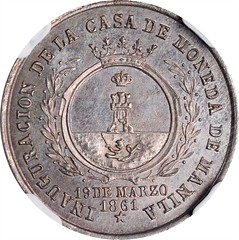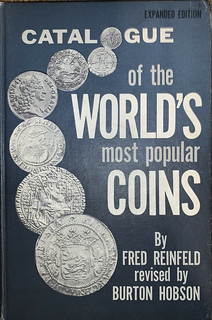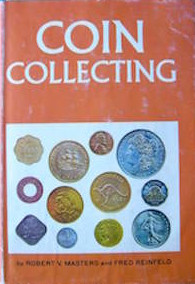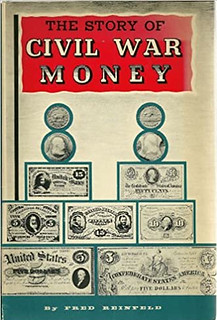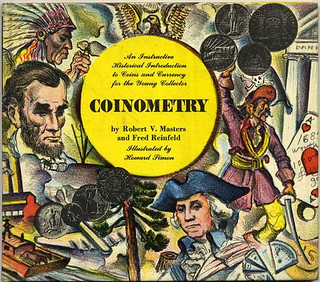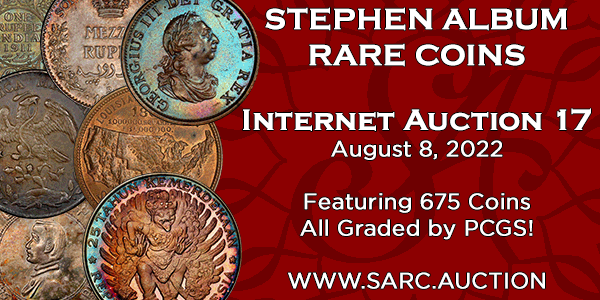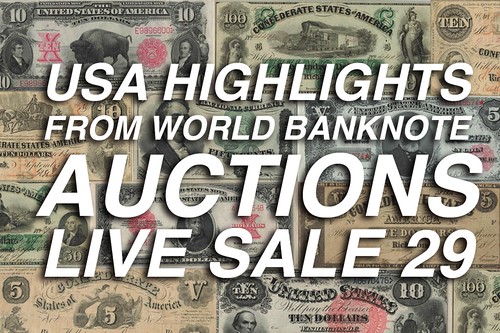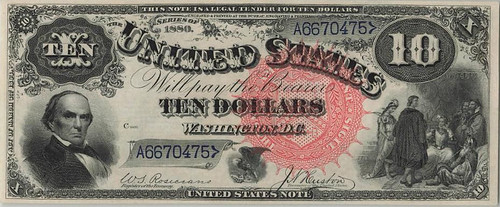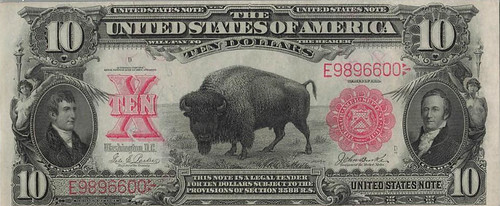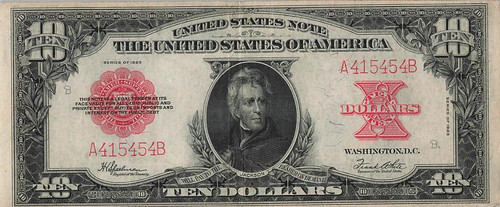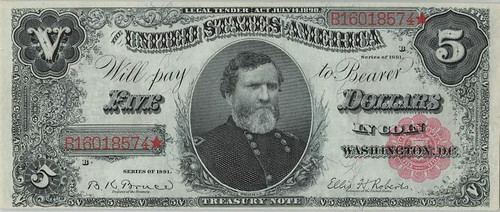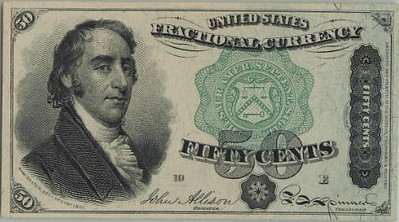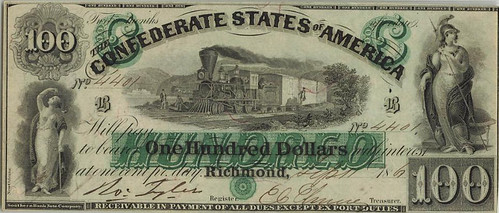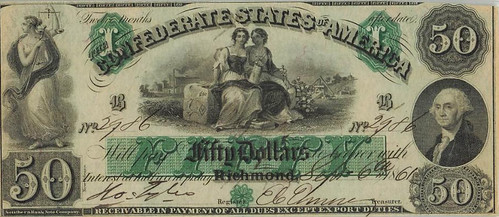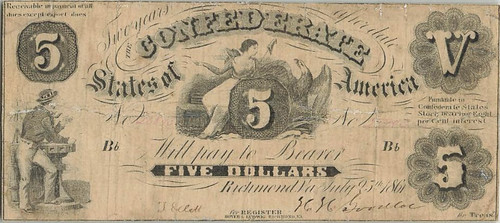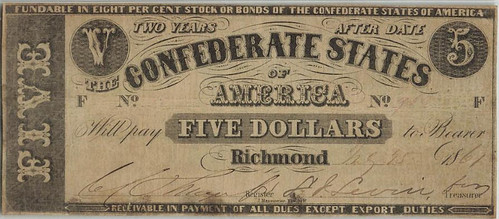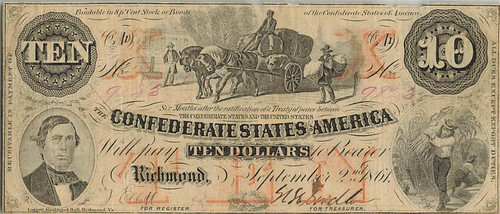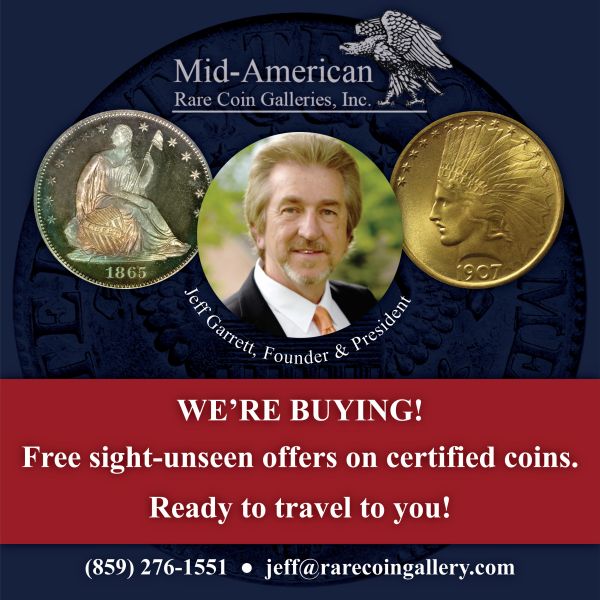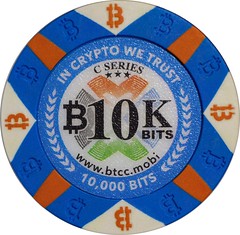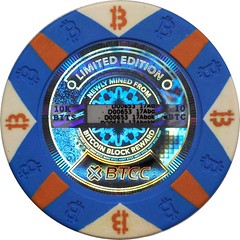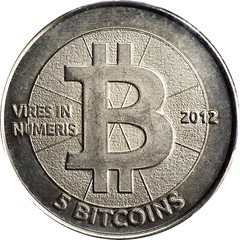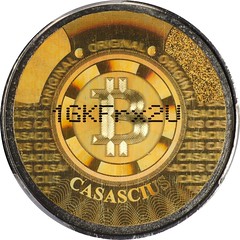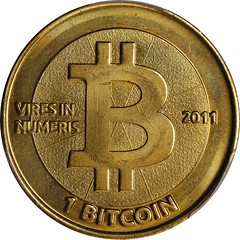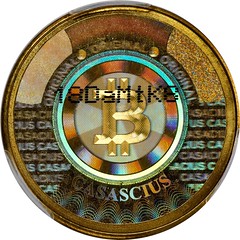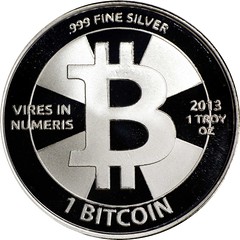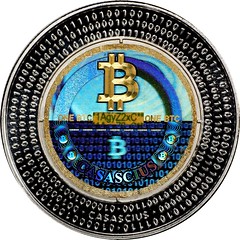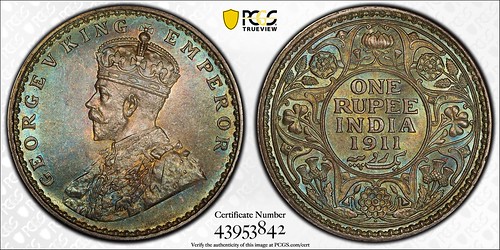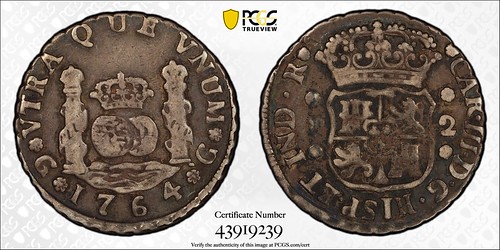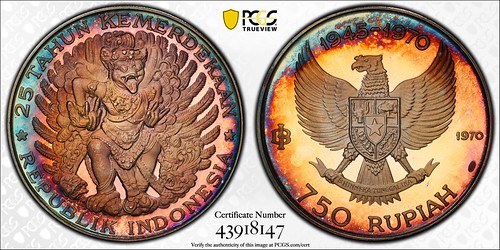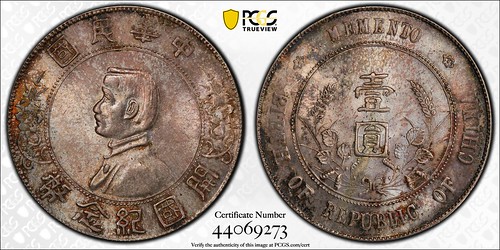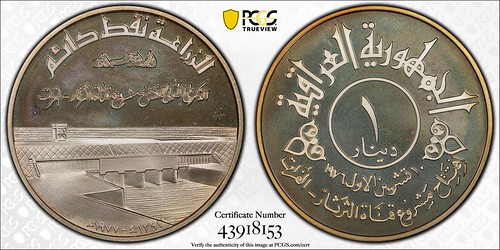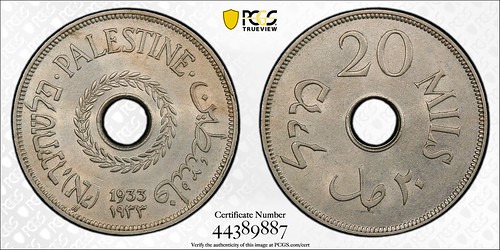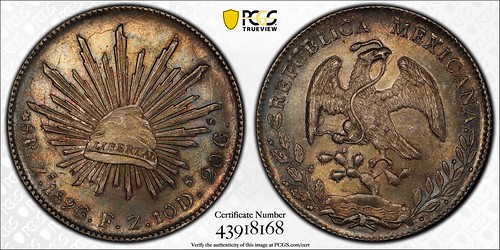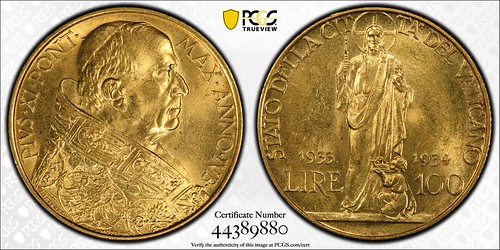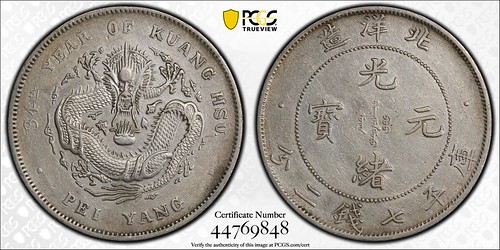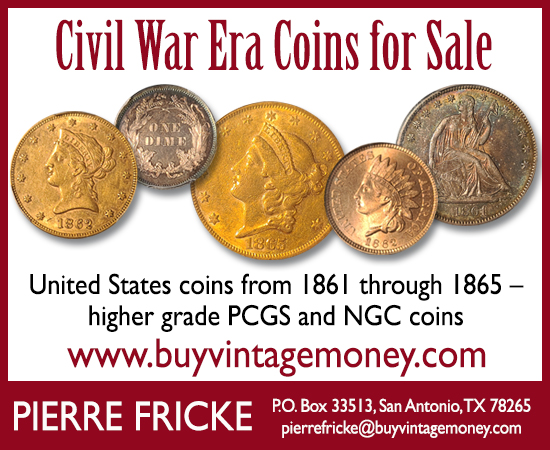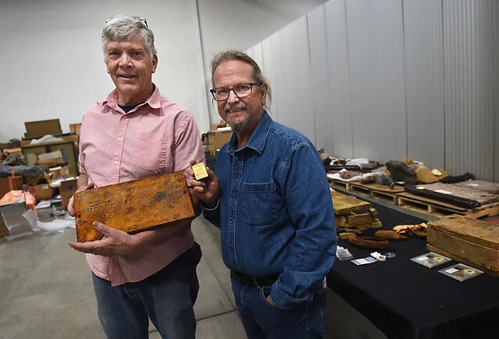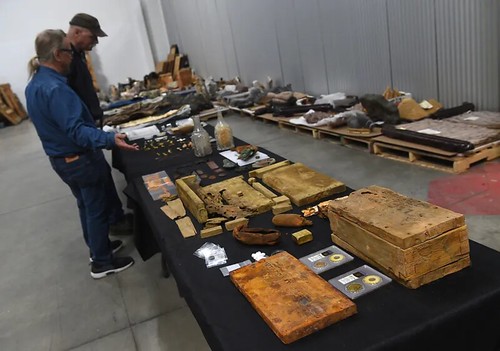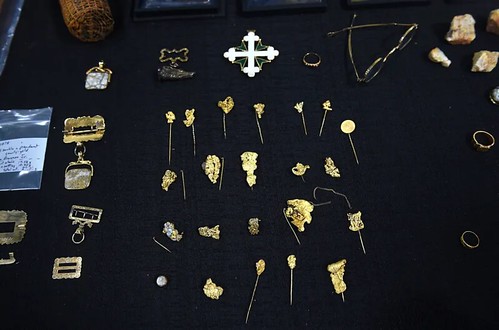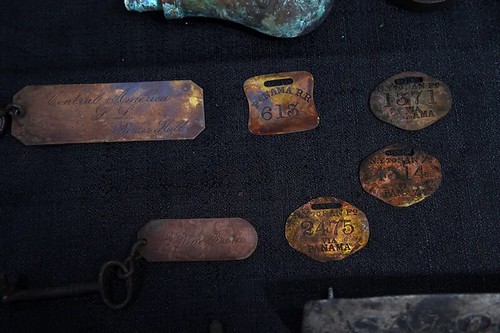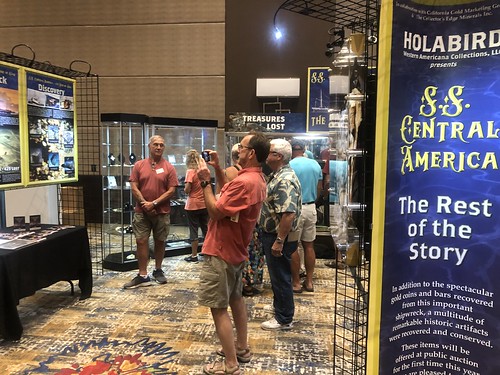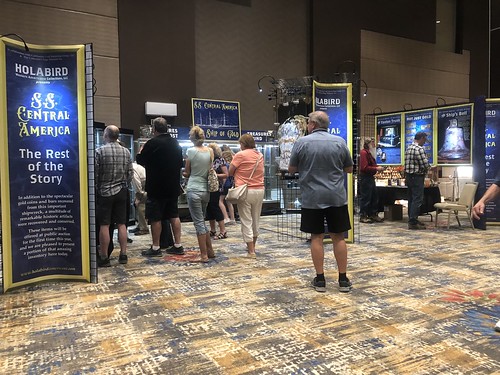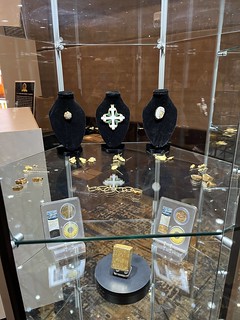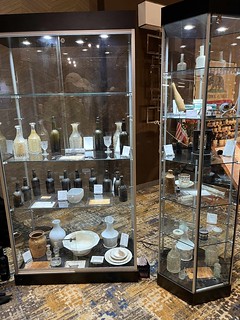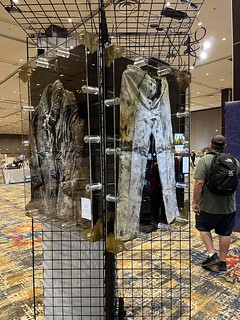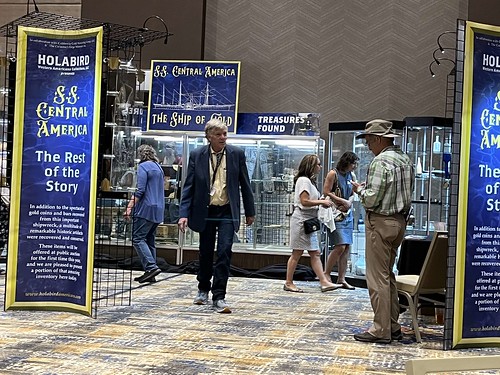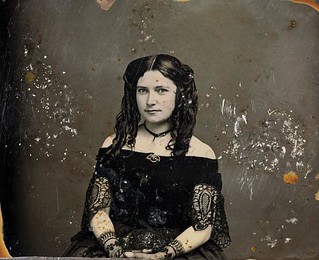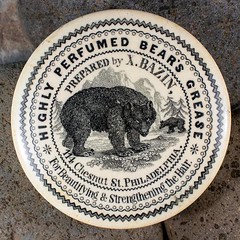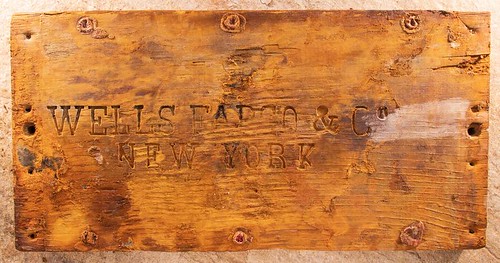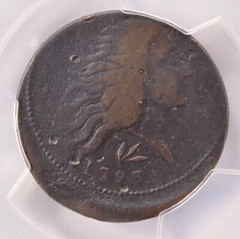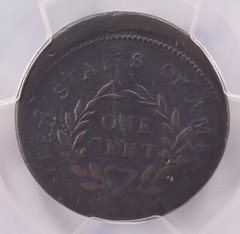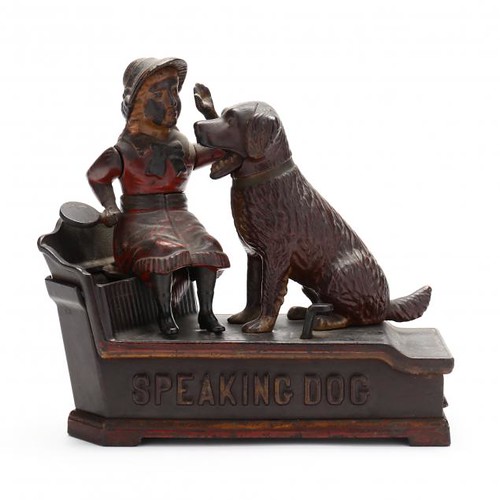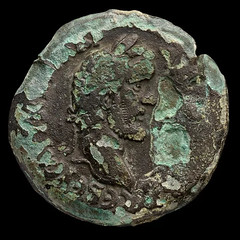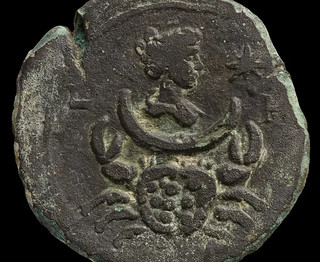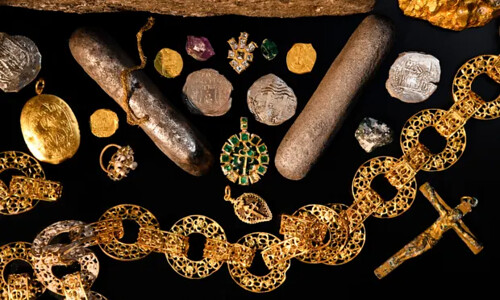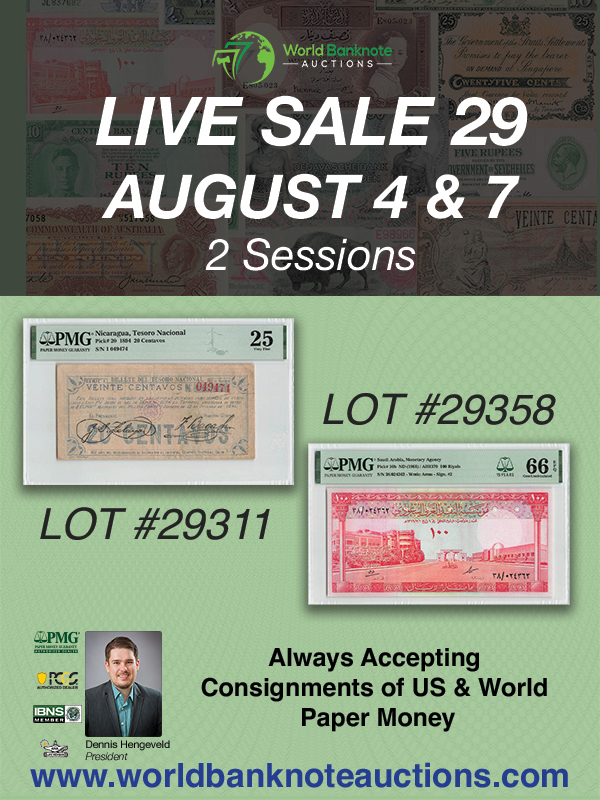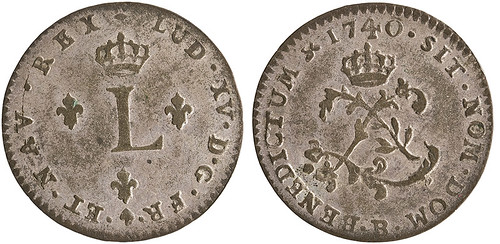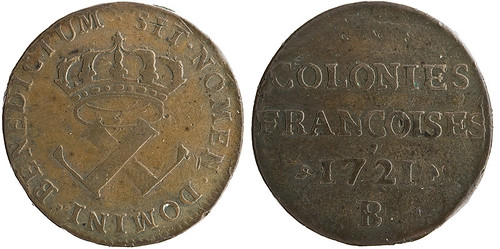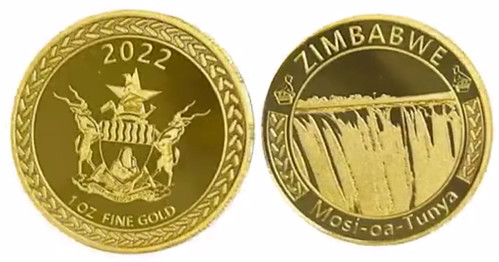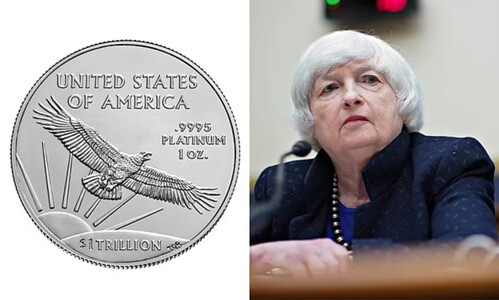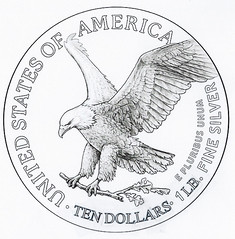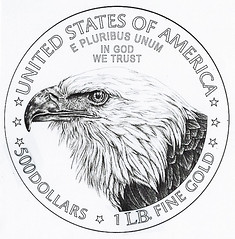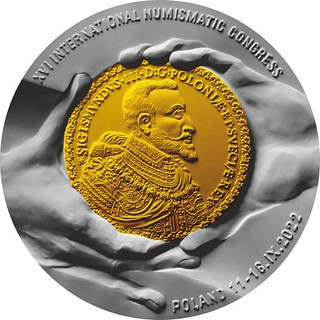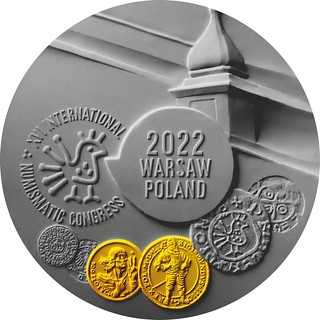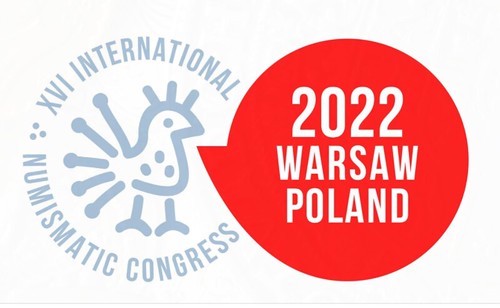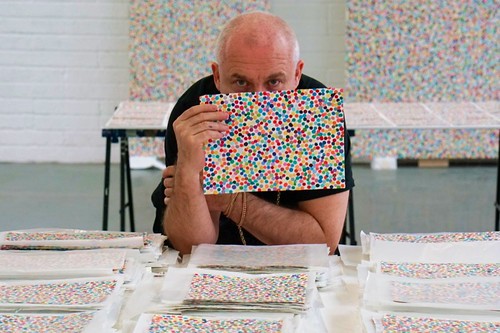
Visit our NBS Sponsors



About UsThe Numismatic Bibliomania Society is a non-profit association devoted to the study and enjoyment of numismatic literature. For more information please see our web site at coinbooks.org SubscriptionsThose wishing to become new E-Sylum subscribers (or wishing to Unsubscribe) can go to the following web page link MembershipThere is a membership application available on the web site Membership Application To join, print the application and return it with your check to the address printed on the application. Print/Digital membership is $40 to addresses in the U.S., and $60 elsewhere. A digital-only membership is available for $25. For those without web access, write to: Charles Heck, Treasurer AsylumFor Asylum mailing address changes and other membership questions, contact Chuck at this email address: treasurer@coinbooks.org SubmissionsTo submit items for publication in The E-Sylum, write to the Editor at this address: whomren@gmail.com BUY THE BOOK BEFORE THE COINSale Calendar |
- WAYNE'S WORDS: THE E-SYLUM JULY 31, 2022
- NBS 2022 ANA CONVENTION EVENT SCHEDULE
- NEW BOOK: PRESBEUS: STUDIES IN ANCIENT COINAGE
- NEW BOOK: CLEANING ANCIENT BRONZE COINS
- NEW BOOK: FORGING SECRETS
- CHARLES III LARGE AL MERITO MEDALS
- DESERET NATIONAL BANK GOLD COIN BAG
- VIDEO: HOUSTON MONEY SHOW
- NOTES FROM E-SYLUM READERS: JULY 31, 2022
- U.S. CATHOLIC MEDAL INFORMATION SOUGHT
- 2022 PHILIPPINE COLLECTORS FORUM
- VOCABULARY TERM: LEGEND
- FRED REINFELD (1910-1964)
- FRED WEINBERG INTERVIEW, PART FOUR
- U.S. PAPER IN WORLD BANKNOTE AUCTIONS SALE 29
- STACK'S BOWERS PHYSICAL CRYPTOCURRENCY
- STEPHEN ALBUM INTERNET AUCTION 17
- DAVISSON'S E-AUCTION 44
- S.S. CENTRAL AMERICA ARTIFACTS EXHIBITED
- NUMISMATIC NUGGETS: JULY 31, 2022
- ARCHAEOLOGISTS FIND RARE ZODIAC COIN
- SPANISH GALLEON MARAVILLAS FOUND
- FRENCH COINS IN AMERICA
- ZIMBABWE INTRODUCES GOLD COINS
- ONE POUND BULLION COINS
- THE INC 2022 CONGRESS MEDAL
- UPDATE: THE CURRENCY BY DAMIEN HIRST
Click here to read the thin version on the web
Click here to subscribe
Click here to access the complete archive
To comment or submit articles, reply to whomren@gmail.com
Content presented in The E-Sylum is not necessarily researched or independently fact-checked, and views expressed do not necessarily represent those of the Numismatic Bibliomania Society.
WAYNE'S WORDS: THE E-SYLUM JULY 31, 2022
 We have one new subscriber this week.
Welcome aboard!
We have one new subscriber this week.
Welcome aboard!
Thank you for reading The E-Sylum. If you enjoy it, please send me the email addresses of friends you think may enjoy it as well and I'll send them a subscription. Contact me at whomren@gmail.com anytime regarding your subscription, or questions, comments or suggestions about our content.
This week we open with an update from NBS, three new books, a new website, updates from the Newman Numismatic Portal, and more.
Other topics this week include cleaning ancient bronze coins, Operation Bernhard, Catholic medals, Fred Reinfeld, Fred Weinberg, auction previews, coin finds, artifacts from the SS Central America, French coins in America, Zimbabwe's gold coins, and the International Numismatic Congress.
To learn more about 1794 United States Large Cents, Charles III Large AL Merito medals, Jeno Juszko, the Victor Buono method, free government checks, Philippine numismatics, the missing $4 Stella, an off-center wreath cent, and The Currency
by artist Damien Hirst, read on. Have a great week, everyone!
Wayne Homren
Editor, The E-Sylum
NBS 2022 ANA CONVENTION EVENT SCHEDULE
It's that time of year, and the American Numismatic Association's annual World's Fair of Money convention is approaching. NBS President Tom Harrison submitted this preview of club events at the show. -Editor
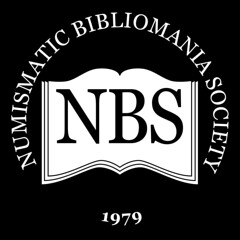 Here are a few highlights of the Numismatic Bibliomania Society's events at the upcoming ANA
Convention in Rosemont the week of August 16th to 20th. Tuesday through Friday the NBS will
host our club table (#730). We hope you will stop by to view a few highlights from Friday's
charity auction, purchase a NBS commemorative coffee mug to support the NBS and, most of
all, share your enthusiasm for the numismatic literature hobby.
Here are a few highlights of the Numismatic Bibliomania Society's events at the upcoming ANA
Convention in Rosemont the week of August 16th to 20th. Tuesday through Friday the NBS will
host our club table (#730). We hope you will stop by to view a few highlights from Friday's
charity auction, purchase a NBS commemorative coffee mug to support the NBS and, most of
all, share your enthusiasm for the numismatic literature hobby.
The NBS Board Meeting will be held on Thursday from 11:30 to 1:00 in room 11. Our Symposium will Immediately follow the Board Meeting at 1:00 also in room 11. We are delighted to have NBS Treasurer and early American coppers authority, Chuck Heck, speaking about his marvelous new book Die States of 1794 United States Large Cents.
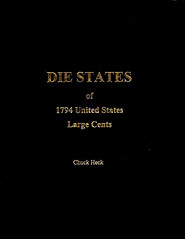 The General Meeting will be Friday at 11:30 in room 12. The meeting will feature The Asylum
author awards, a video tour of the extensive library of NBS Historian, Joel Orosz and our all-
important charity auction. The auction catalog will be posted on the NBS website
www.coinbooks.org. David Fanning cataloged the sale and will accept absentee bids by phone
(614)256-8915 or email
df@numislit.com until 5PM central time Thursday, August 18th.
The General Meeting will be Friday at 11:30 in room 12. The meeting will feature The Asylum
author awards, a video tour of the extensive library of NBS Historian, Joel Orosz and our all-
important charity auction. The auction catalog will be posted on the NBS website
www.coinbooks.org. David Fanning cataloged the sale and will accept absentee bids by phone
(614)256-8915 or email
df@numislit.com until 5PM central time Thursday, August 18th.
If your schedule permits, we would like to invite those attending the General Meeting to remain after the formal meeting to enjoy an informal social time. We encourage you to bring a special item from your library to share or just stay for the fellowship. While it will be fun to see what others bring, the goal is to provide an opportunity to connect with your fellow biblio enthusiasts.
Thank you to everyone who has stepped up to serve and support the NBS during our annual events. We look forward to seeing you at the NBS events!
For more information on the book, see:
NEW BOOK: DIE STATES OF 1794 LARGE CENTS
(https://www.coinbooks.org/v25/esylum_v25n22a04.html)
NEW BOOK: PRESBEUS: STUDIES IN ANCIENT COINAGE
A new book on ancient coinage has been published by the American Numismatic Society. -Editor
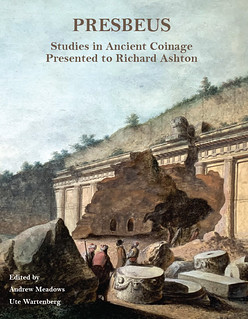 Presbeus: Studies in Ancient Coinage Presented to Richard Ashton
Presbeus: Studies in Ancient Coinage Presented to Richard Ashton
Edited by Andrew Meadows and Ute Wartenberg, this Festschrift is presented to numismatic scholar Richard Ashton on the occasion of his 75th birthday. These 20 articles present new research into the numismatics of the Greek East and provide significant advances in archaeological, historical, and numismatic scholarship:
- Christopher S. Lightfoot. Was there a Core-Formed Glass Industry in Archaic Rhodes?
- Wolfgang R. Fischer-Bossert. The Electrum Coinage of Lindos Again
- Alain Bresson. Palmette Coins: An Update
- Jonathan Kagan. Return to Xanthos: New Numismatic Light on the Harpagid Dynasty of Western Lycia
- Ute Wartenberg. A Persian Queen on the Black Sea: The Coinages of Amastris and Herakleia
- Philip Kinns. Understanding the Later Civic Coinage of Miletus
- Koray Konuk. MY Stands for Mylasa
- Andrew Meadows. The Double-Axe Mint: The Coinage of Tenedos in the Third and Second Centuries BC
- Amelia Dowler. The New Mint under Nicomedes I (c. 278–255 BC)
- Kerstin Höghammar. The Koan Series of Posthumous Alexander Tetradrachms, c. 200 BC
- Vassiliki E. Stefanaki. Les ‘plinthophores' de Cos: état de la question
- Peter Thonemann. Cistophoric Geography Revisited
- Aneurin Ellis-Evans. The Wreathed Tetradrachms and Gold Staters of Magnesia on the Maeander
- Nicholas Sekunda. The Cretan and Pisidian Keraitai
- Lucia Carbone. The Standardization of Asian Bronze Denominations in the First Century BC
- Fabrice Delrieux. Fleuves et riviéres de l'Asie Mineure gréco-romaine. Généralités et tudes de cas dans les monnayages de Carie
- Laurent Bricault. Images civiques de Mithra
- Andrew Burnett. The Severan Coinage of Galatia
- Elena Korka, Constantine Lagos, and Maria Syrrou. An Early Byzantine Gold Hoard from Tenea, Corinthia
- François de Callataÿ. Correspondence about the Coin Market in Constantinople and Smyrna Prior to 1800
For more information, or to order, see:
Presbeus: Studies in Ancient Coinage Presented to Richard Ashton [Hardback]
(https://www.oxbowbooks.com/dbbc/presbeus.html)
NEW BOOK: CLEANING ANCIENT BRONZE COINS
A recent Coin World article by Jeff Starck alerted me to a new book on cleaning ancient coins. Great subtitle! The author certainly has a sense of humor about the topic. Jeff calls it "a lighthearted but learned look at an issue that is common in collecting ancient coins." -Editor
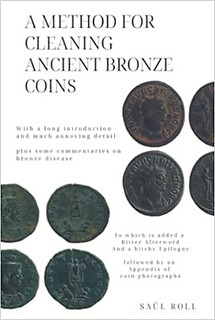 A Method for Cleaning Ancient Bronze Coins: With a long introduction and much annoying detail, plus some commentaries on bronze disease, to which is ... followed by an Appendix of coin photographs
A Method for Cleaning Ancient Bronze Coins: With a long introduction and much annoying detail, plus some commentaries on bronze disease, to which is ... followed by an Appendix of coin photographs
by Saúl Roll (Author), Maria Jacqueline Hauser (Editor)
This book is meant to accompany the "Ancient Coin Cleaning Kit" sold on my web store. What I explain here are all my personal opinions, based on my personal experience, and they are not meant to convince the reader of anything. You are welcome to try these techniques on your own coins at your own risk, as I cannot be responsible for accidents, damaged coins, personal injury, or any other catastrophes that may result from following these steps. Of course, I expect none of that will happen, but you never know when someone is going to poke their hand with a cleaning tool, bump the distilled water with the coins on the new rug, and react with a rapid movement that will knock down the microscope on the dog's head, who was distractedly licking the sodium sesquicarbonate spill, rendering him unconscious, all which would incite the coin cleaner to sue whoever suggested the cleaning method in the first place. So please be careful, as I am not liable for your mistakes, accidents, acts of Apollo, etc. Also, cleaning coins kills your back and your neck, so keep a good posture and take breaks often.
The book is only available through Amazon, and is available in three formats: hardcover $25, Paperback $18, and Kindle reader $9. -Editor
For more information, or to order, see:
A Method for Cleaning Ancient Bronze Coins: With a long introduction and much annoying detail, plus some commentaries on bronze disease, to which is ... followed by an Appendix of coin photographs Hardcover – July 25, 2022
(https://www.amazon.com/Method-Cleaning-Ancient-Bronze-Coins/dp/B0B7QG3CRD/ref=sr_1_1)
NEW BOOK: FORGING SECRETS
Here's some more information about the new Forging Secrets book about the Operation Bernhard counterfeits of WWII. -Editor
Museum-quality book features never-before-seen accounts from numismatists, historians, descendants of Holocaust survivors, and the granddaughter of the Nazi who ran Operation Bernhard
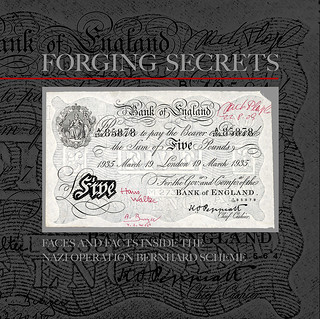 A new book titled Forging Secrets: Faces and Facts Inside the Nazi Operation Bernhard Scheme will become available to the public at a special event at the Hyatt Regency Chicago O'Hare on Thursday, August 18, 2022. Collectors, students, and researchers of World War II and the Holocaust will be captivated by this unique publication by the Spungen Family Foundation in association with Coin and Currency Institute.
A new book titled Forging Secrets: Faces and Facts Inside the Nazi Operation Bernhard Scheme will become available to the public at a special event at the Hyatt Regency Chicago O'Hare on Thursday, August 18, 2022. Collectors, students, and researchers of World War II and the Holocaust will be captivated by this unique publication by the Spungen Family Foundation in association with Coin and Currency Institute.
Operation Bernhard was a secret Nazi project during WWII that forced Jewish concentration camp prisoners to forge Bank of England notes. Initially intended to destroy the British economy, the forged notes ended up financing the German side of the war. With their lives hanging by a thread, 140-plus prisoners produced enough fake currency to equal the face value of all reserves in the vaults of the Bank of England—an astounding 6 or 7 billion dollars in today's money. This sensational true story has been treated by historians, survivors, Hollywood, and mainstream media, but never have all of these elements been combined into one volume.
We wanted to put a face on money - to show the humanity behind this incredible story for students and future generations who take an interest in the Holocaust and World War II,
said Danny Spungen, trustee of the Spungen Family Foundation. This is more than a book. This is an interactive experience in a book where students and collectors can search for and acquire an artifact, witnesses of the Holocaust.
Contributors to the book include American Numismatic Association Medal of Merit recipients Joseph Boling and C. Frederick Schwan; Auschwitz historian and museum curator Robert Jan van Pelt; Debbie Walter, daughter of Operation Bernhard survivor Hans Walter; Charlotte Krüger, granddaughter of Bernhard Krüger, who ran Operation Bernhard; and Astrid Ley and Agnes Ohm, expert historians from the Sachsenhausen Memorial and Museum near Berlin.
Collectors will be fascinated by the authoritative chapter by Boling, which shows readers in over 200 diagnostic photos how to distinguish genuine British white notes from fakes produced by the Operation Bernhard prisoners. Boling served as chief editor of the book, along with Danny Spungen and Kiel Majewski, executive director of the Spungen Family Foundation. Several other researchers and historians also contributed original content.
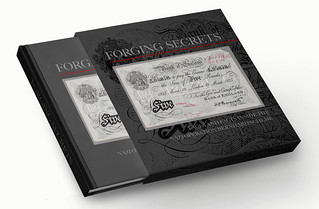 The book features over 500 images, including never-before-published sketches of Bernhard prisoners by the artists Peter Edel and Leo Haas, who were themselves prisoners in the forgery operation. Perhaps the most unique feature of the hardcover, linen-wrapped book is a die-cut window in the cover. The window opens up to a museum-quality transparent polyester sleeve stitched into the book and sized precisely to hold an artifact—a counterfeit
The book features over 500 images, including never-before-published sketches of Bernhard prisoners by the artists Peter Edel and Leo Haas, who were themselves prisoners in the forgery operation. Perhaps the most unique feature of the hardcover, linen-wrapped book is a die-cut window in the cover. The window opens up to a museum-quality transparent polyester sleeve stitched into the book and sized precisely to hold an artifact—a counterfeit Operation Bernhard
note produced by the prisoners of Block 19 in Sachsenhausen. Retail copies of the book will come with a replica Bernhard note depicting the signatures of three survivors of Block 19—Adolf Burger, Jack Plapler, and Hans Walter. Guidance on how to conserve an authentic Bernhard note is printed on the backside of the replica.
Each copy of the short-run collectible book will be numbered 1-1000 and will retail for $199. Thanks to the generous contributions of donors and sponsors, 200+ copies will be made available to students at an 85% discount. Available from bookstores, coin and paper money dealers, at trade shows, and from internet book sellers. Copies may also be obtained from the Coin & Currency Institute, www.coin-currency.com, +1 800 421 1866. Free shipping in the USA. Foreign orders will be billed actual cost.
For more information about book launch events in the United States, the Netherlands, and Germany, contact Danny Spungen at danny@spungenfoundation.org / +1 847 775 4675.
To read the earlier E-Sylum article, see:
NEW BOOK: FORGING SECRETS
(https://www.coinbooks.org/v25/esylum_v25n28a04.html)
CHARLES III LARGE AL MERITO MEDALS
Skyler Liechty passed along this note about a new website about Charles III Large AL Merito medals. -Editor
With the ever increasing interest in the importance of Spanish Indian Peace medals, and the significant role the Spanish played in American colonial history, the authors of the chapter on those medals in the now out of print volume on Indian Peace medals published by the Gilcrease Museum in 2011 (Peace Medals Negotiating Power in Early America), a work that happily married the academic world with numismatic scholarship, the authors obtained permission to republish their chapter on those Spanish medals as a website available to all, which was granted. The new website illustrates new discoveries, and is offered in the hope that it will spur others to contribute new information, and any new finds. While not intended as an authentication, or evaluation service, the authors welcome all inquiries.
To visit the website, see:
http://www.charlesiiialmerito.com/
DESERET NATIONAL BANK GOLD COIN BAG
Newman Numismatic Portal Project Coordinator Len Augsburger provided the following item. Thanks. -Editor
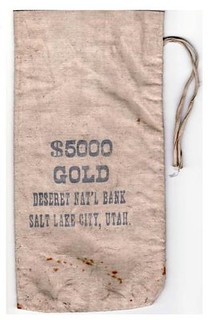 Following up on the recent discussion on U.S. Mint bags, banks similarly produce bags for the purposes of storing and transporting coinage. The July issue of The Mint Master, published by the Utah Numismatic Society and edited by Doug Nyholm, included illustrations of a number of Utah bank bags.
Following up on the recent discussion on U.S. Mint bags, banks similarly produce bags for the purposes of storing and transporting coinage. The July issue of The Mint Master, published by the Utah Numismatic Society and edited by Doug Nyholm, included illustrations of a number of Utah bank bags.
The illustrated bag from the Deseret National Bank is labeled $5000 GOLD,
and is presumably intended to contain 250 double eagles. This bank was incorporated in 1871, with the LDS leader Brigham Young as president, and ultimately consolidated into the Security National Bank of Salt Lake City in 1932.
Link to The Mint Master on Newman Portal:
https://nnp.wustl.edu/library/publisherdetail/533919
VIDEO: HOUSTON MONEY SHOW
These are selections from the David Lisot Video Library that feature news and personalities from the world of coin collecting. David has been attending coin conventions since 1972 and began videotaping in 1985. The Newman Numismatic Portal now lists all David's videos on their website at:
https://nnp.wustl.edu/library/multimediadetail/522852
Here's one on the Houston Money Show. -Editor
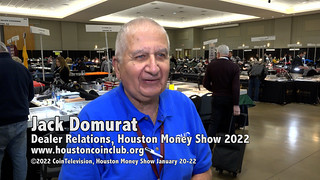 Greater Houston Coin Club Continues to Sponsor Houston Money Show 2022.
Greater Houston Coin Club Continues to Sponsor Houston Money Show 2022.
VIDEO: 3:38.
Jack Domurat, Dealer Relations, Houston Money Show,
David Lisot, Interviewer, CoinTelevision.com.
January 21, 2022.
The Houston Money Show continues to grow in importance as one of the first conventions held as the numismatic year begins every January. Jack Domurat handles dealer relations for the coin convention as well as being president of the Great Houston Coin Club. He shares how GHCC continues to be an important convention and why the Greater Houston Coin Club is so beneficial to collectors.
David adds:
"Jack Domurat is president of the Greater Houston Coin Club. Jack and his team of volunteers work to put on one of the best coin shows in Texas. The Houston Money Show has everything going for it to be a great show; convenient location, lots of collectors, a good base of coin dealers, and a committed staff of folks to make it a great experience. The next Houston Money Show is in January 2023. You will not want to miss it!"
An excerpt of the video is available for viewing on the Coin Television YouTube Channel at:
https://youtu.be/q-Fsn3T0sjc
NOTES FROM E-SYLUM READERS: JULY 31, 2022
Novel vs. Noble Deeds
"I saw the "Novel" Deeds medal with the reversed illustration in the Express a day or two ago and contacted the journalist to point out that "Edel" on the medal would be better translated as "Noble" rather than "Novel" but got no response. I assume it was a mis-hearing of what the speaker said on the TV show in that particular report. In any case, "novel" is certainly a novel expression in context!"
That makes more sense! Thanks. -Editor
To read the earlier E-Sylum article, see:
FOR EDEL DAAD: THE NOVEL DEEDS MEDAL
(https://www.coinbooks.org/v25/esylum_v25n30a27.html)
Jeno Juszko
Scott Miller writes:
"Regarding the Teddy Roosevelt plaque displayed at the Nummis Nova dinner, the artist should be listed as Jeno Juszko. While primarily known as a medalist, Juszko also created some statues and busts, including three at Grant's Tomb - Generals Thomas, McPherson and Ord."
Thanks! Scott passed along a photo of Juszko at work. -Editor
To read the complete article, see:
File:Archives of American Art - Jeno Juszko - 2974.jpg
(https://commons.wikimedia.org/wiki/File:Archives_of_American_Art_-_Jeno_Juszko_-_2974.jpg)
To read the earlier E-Sylum article, see:
WAYNE'S NUMISMATIC DIARY: JULY 24, 2022 : Tom's Notes from the Far end of the Table
(https://www.coinbooks.org/v25/esylum_v25n30a21.html)
The Victor Buono Method
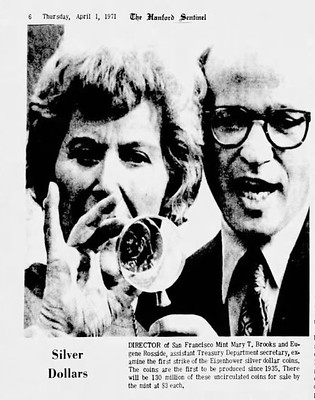 Regarding Pete Smith's question about "the Victor Buono method,"
Dave Lange writes:
Regarding Pete Smith's question about "the Victor Buono method,"
Dave Lange writes:
"I'm not certain what the "Victor Buono Method" is, but I imagine it pertains to the 1973 episode of Hawaii Five-0 in which Buono appeared as a criminal seeking to swap a fake 1913 Liberty Head Nickel for the real one. I remember watching that entry when it first aired, but I haven't seen it since. I imagine the show is being re-run on some network, but I haven't searched for it."
Bill Daehn writes:
"I think I've got the answer to Pete Smith's question on the Victor Buono method.
It is to examine a coin (preferably a 1913 Liberty Nickel) by holding the magnifying glass behind the coin rather than in front of the coin. This scene was used to promote the Hawaii Five-O episode featuring the famous nickel."
Pete writes:
"Good answer. Bill is one of my oldest friends in numismatics, going back to about 1985."
Pete's question was inspired by the above newspaper photo of Mint Director Mary Brooks examining a coin. Victor Buono is the prolific character actor who guest starred in the said Hawaii Five-O episode. Here's the photo in question. -Editor
In both photos the magnifying glass is not between the coin and the person looking at the coin - it's on the outside toward the photographer so people viewing the photo see the coin thru the magnifying glass. As Dave Lange noted, "It's definitely a posed production still." -Editor
To read the earlier E-Sylum articles, see:
NOTES FROM E-SYLUM READERS: JULY 24, 2016 :
Quick Quiz: Who's in This 1913 Liberty Nickel Picture?
(https://www.coinbooks.org/esylum_v19n30a09.html)
NOTES FROM E-SYLUM READERS: JULY 31, 2016 : Quiz Answer: Who's in This 1913 Liberty Nickel Picture?
(https://www.coinbooks.org/esylum_v19n31a14.html)
NOTES FROM E-SYLUM READERS: JULY 24, 2022 : The Victor Buono Method
(https://www.coinbooks.org/v25/esylum_v25n30a09.html)
The Racketeer Nickel Silence Loophole
Regarding Josh Tatum and the Racketeer Nickel,
Julia Casey writes:
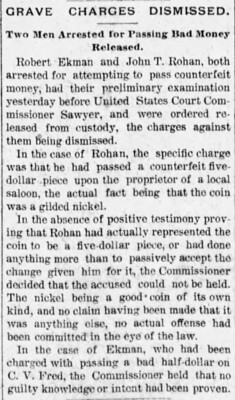 "I don't have anything major to share -- but just this morning it came to me that there is a real possibility this all started with Cecil/Charles Ryan.
"I don't have anything major to share -- but just this morning it came to me that there is a real possibility this all started with Cecil/Charles Ryan.
"I started looking for records from the Brooklyn Coin Club (where he seems to be most active) and I ran into Paul Franklin being active there as well at this time. I also think these two men lived near each other.
"The Josh Tatum story certainly took hold in American legend. Could it have been concocted by Franklin and Ryan - with that helpful spin of MacDougall (who got a nice column out of it). It probably helped sell a lot of racketeer nickels and there is the possibility that some of them could have been more modernly made for collectors.
"Apparently the concept of not asking for change for the gilded nickels was known as a potential loop-hole. Attached here is an article that makes mention of it from the San Francisco Examiner, 2/28/1890."
Thanks - another piece of the puzzle. -Editor
To read the earlier E-Sylum article, see:
JOSH TATUM REVISITED
(https://www.coinbooks.org/v25/esylum_v25n30a12.html)
Uncle Sam's Free Numismatic Collectibles
In a followup to his adventure collecting an uncashed U.S. treasury check,
Kavan Ratnatunga of Sri Lanka writes:
"A year went by, and the US$ 12 Tax refund cheque was uncashed safe in my collection. To my total surprise, I got another US$12 check in the mail which I never requested when I submitted my taxes this year. Dated June 17 2022 it had been posted by the US Embassy on July 27 and reached me on 29th. I checked and found my full 2021 refund had been deposited. I can only guess that this is a replacement for the uncashed cheque which was valid for only one Year.
"Uncle Sam's automated computer system has clearly not been programmed to handle uncashed cheques kept by collectors. Wondering if I should just add it to my collection and see what happens next year. :-)"
Wow - guess I never expected that to happen. Interesting development. -Editor
To read the earlier E-Sylum articles, see:
WILL CORONAVIRUS STIMULUS CHECKS BE COLLECTIBLE?
(https://www.coinbooks.org/v23/esylum_v23n16a33.html)
CARES ACT TREASURY CHECK SECURITY FEATURES
(https://www.coinbooks.org/v23/esylum_v23n18a29.html)
NOTES FROM E-SYLUM READERS: AUGUST 1, 2021 : Collecting U.S. Treasury Checks
(https://www.coinbooks.org/v24/esylum_v24n31a16.html)
Query: 1963 Famous Old Collection Sale
Dave Hirt writes:
"I was looking through some items and came across an auction of the Columbus Stamp and Coin Shop, titled Famous Old Collection. It closed March, 26, 1963. The sale was printed in the March issue of The Numismatic Scrapbook Magazine. I have a copy of this version. I have read that some original copies of the catalog were printed. Do any of our readers own these?"
Great question - readers? -Editor
Counterstamped Chinese Cash Coin Identified
Ted Puls writes:
"The Chien Lung reign cash shown with the counterstamp appears to be a coin of the Board of Works-New Mint made in 1752 according to "Ching Cash" book by Warren Burger- prior to the start of adding privy marks to indicate clearly the branch of the B.O.W. mint branches. The coin has a diameter of about 25 mm and wide rim width of 4 mm. A bit of useless trivia but allowed me to use my new book."
Thanks! -Editor
To read the earlier E-Sylum article, see:
NUMISMATIC NUGGETS: JULY 24, 2022 : Nanking Inn Counterstamp
(https://www.coinbooks.org/v25/esylum_v25n30a20.html)
U.S. CATHOLIC MEDAL INFORMATION SOUGHT
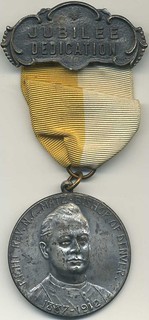 As you have read in a previous issue of The E-Sylum, George Cuhaj was awarded an Eric
P. Newman Numismatic Education Society grant for a catalog project researching medals
of the United States Catholic Hierarchy, Cathedrals and Dioceses.
As you have read in a previous issue of The E-Sylum, George Cuhaj was awarded an Eric
P. Newman Numismatic Education Society grant for a catalog project researching medals
of the United States Catholic Hierarchy, Cathedrals and Dioceses.
The scope of the work will include portrait medals depicting bishops, archbishops and cardinals. Renderings of their coat-of-arms, diocesan shields and cathedral views are also of interest. Catholic seminary awards will also be included. Looped and ribboned medals will also be included.
If you have some of these, Cuhaj is willing to correspond and share an Excel list of some 450 known pieces (including metal and size varieties) to see if you may have an elusive item which he would like to include. Thank you for your interest and assistance. That excel file can be requested directly from him at George.cuhaj@yahoo.com.
To read the earlier E-Sylum article, see:
NEWMAN GRANTS 2022 AWARD ANNOUNCEMENT
(https://www.coinbooks.org/v25/esylum_v25n22a10.html)
2022 PHILIPPINE COLLECTORS FORUM
The American Numismatic Association World's Fair of Money convention is coming up and there will be many opportunities to learn from top researchers and authors. From a recent announcement by Ray Czahor, here's information about the Philippine Collectors Forum. -Editor
Join us at the Summer ANA show in Rosemont, Illinois for the 20th annual meeting of the Philippine Collectors Forum! The meeting will convene at 1 pm Central Time on Friday, August 19 in Room 11 of the Donald Stephens Convention Center. The great door prize raffle will be back and ** WE ARE WELCOMING ANY NEW AND ALL SHOW & TELL
PRESENTERS. Just let moderator John Riley know (johnrriley@yahoo.com).
While enjoying the bourse at the Worlds Fair of Money, be sure to check out and vote on member Floyd April's collector exhibit on medals and other issues commemorating establishment in 1935 of the Philippines Commonwealth.
Presentations at his year's PCF include :
- Neil Shafer speaking on the new volume II of the Guidebook to Philippines Emergency Money of WWII.
- Ken Seymore on Recent Wilson Dollar Discoveries
- Kelly Norris on USPI Coin Varieties and Errors
-
Roger Urce, Some New Observations with Emergency Notes (
Guerilla Money
) - Earl Honeycutt on Highlights of Philippine Medals and Tokens
- Dennis Tucker - highlights of recent trip to the Philippines and WWII Exhibit at Old Fort Santiago.
- John Riley - revisiting Japanese Occupation period medals
Note that a 2020 74th edition of the Special Edition of the Redbook will be auctioned off with all proceeds going to the PCF. Note that this edition is in high demand and scarce to find. Please participate via email to John Riley or live bidding at the PCF meeting.
VOCABULARY TERM: LEGEND
Here's another entry from Dick Johnson's Encyclopedia of Coin and Medal Terminology. -Editor
Legend. The lettering following the contour, circumference or outer shape of a coin or medal; the wording near the edge, most often in a form of an arc just inside the border. Lettering in such an arc is called bowed (the letters have a bowed base line). The legend differs from inscription (virtually all other lettering on a numismatic or medallic piece, on a straight base line, most often horizontal); it also differs from the exergue (lettering in the area below a line across the bottom of the device). Legends on coins and medals reinforce the theme and concept of their design and occasionally are like the wider meaning of the word legend: repeating a statement from a previous generation. In England legends are called circumscriptions.
The wording in a legend is often contracted or abbreviated to get the required statement into a small space. Also legends are often in a language different from the country issued – as Latin – to further add to their obscurity. Translating legends, however, is a vital function of numismatic study and legends are often indexed in numismatic literature.
A legend containing errors of any kind (misspelled words or titles, errors of dates or figures, or mis-struck letters) is called blundered legend. Legends normally run clockwise, or left to right, however Arabic and other languages read right to left. Legend is also the lettering on a coat of arms or heraldic shield in any position. The legend may also be a motto, somewhat of a slogan, if it appears next to the border.
Multiple line legends. The legend is usually only one row of lettering along the rim, adjacent to the border or border elements. However, the legend may be more than one line. Such a double legend was used as early as 1250 on French coins. Modern examples of doubled and multiple legend are illustrated.
Three or more lines of legend are rare, but do exist. An extreme case is a six-line multiple legend on the Barcelona Columns of Julia Augusta Medal of 1970, issued by Calico in Spain. The legend has a list of countries throughout the world with cities named Barcelona. A spiral legend is a circular legend that runs in an ever decreasing pathway inside previous lettering, a volute, often to the very center of the design.
Early legend technique. Hill and Pollard in Medals of the Renaissance tell of early portrait medals modeled on a disk and the legend modeled on a separate ring that fits closely around the disk. Examples are found with the lettering in different positions in relation to the portrait, so the ring was kept separate, and rotated to different positions between castings. This method was employed in the 15th century by Amadeo da Milano, a jeweler turned medallist, by Enzola and others.
See border.
References:
N19 {1993} Mackay, p 51-77.
O10 {1920} Hill.
To read the complete entry on the Newman Numismatic Portal, see:
Legend
(https://nnp.wustl.edu/library/dictionarydetail/516224)
FRED REINFELD (1910-1964)
American Numismatic Biographies author Pete Smith submitted this article on author Fred Reinfeld. Thanks! -Editor
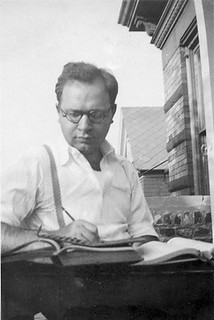 Who was the most prolific author in numismatics? That may depend on how you count.
One possibility was Fred Reinfeld. He is credited with writing more than 260 books with
most of those about chess. I do not have an example in my library.
Who was the most prolific author in numismatics? That may depend on how you count.
One possibility was Fred Reinfeld. He is credited with writing more than 260 books with
most of those about chess. I do not have an example in my library.
My father played chess, read chess books and owned a few chess books. I never paid attention to the author of those books. My father may have had a larger collection of Reinfeld books than I do.
Reinfeld was born in New York City on January 27, 1910, and lived within the boroughs for the rest of his life. His father was a carpenter, Barnett Reinfeld (1883-1959). His mother was the former Rose Pograzelsky (1886-1949). At one time, the family owned a candy store. Barnett remarried in 1950 after the death of Rose.
Fred Reinfeld learned to play chess at age 9 and played on his high school team. With no chess books available, he studied at the library and copied the moves for more than a thousand past games. In 1926, he became active with the Marshall Chess Club.
He studied accounting at New York University and City College of New York. While at NYU, he won the National Chess Federation intercollegiate championship in 1929. He won the New York State chess championship in 1931 and 1933. He was highly ranked within the United States but never played out of the country.
He married Beatrice Levine in the Bronx on December 10, 1932. They had a son and a daughter. The couple operated Black Knight Press, publishing books on chess and a series called Modern Chess Library. Reinfeld stopped playing in competition when his son was born in 1942.
He began work as copy editor for Dial Press. His income was supplemented by his writing of chess books. Reinfeld began writing for Chess Review in 1933 and by 1947 he was their senior editor.
He wrote his first chess book in 1932. Commentary offered a ‘play-by-play' account of important past games. His books helped to popularize chess for beginners. He found that books intended for advanced players did not sell as well as those targeted for novices.
Reinfeld taught chess through community education classes at NYU and Columbia. Later in life he was on staff in the School of General Education at New York University.
His first non-chess book was an abridged version of Oliver Twist in 1948. When he died in 1964, he was credited with 260 books in 32 years or an average of more that eight per year. His peak production was 13 books in one year.
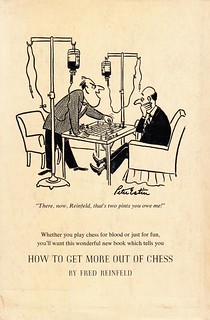 Chess was not a professional sport. He wrote,
Chess was not a professional sport. He wrote, I played and wrote seriously - and got
nothing for it. When I pour out mass-produced trash, the royalties come rolling in.
Reinfeld had a great memory for anything he read and could make himself an expert on any topic. He wrote additional books on the topics of astronomy, checkers, geology, history, jurisprudence, medicine, philately, physics and political science.
His first numismatic book was published in 1952 by Sterling Books, then owned by David Boehm. Boehm contributed under the pen name of Robert V. Masters. Reinfeld was secretary-treasurer for Sterling with Burton Hobson as sales manager.
He wrote nineteen books on numismatics between 1952 and his death in 1964. They were lavishly illustrated with photos. Some titles were published after his death. A list compiled by Len Augsburger was published in Rare Coin Review in December 2000.
Reinfeld joined the American Numismatic Association in 1953 as member 20858. His numismatic books were promoted and marketed through ads in The Numismatist. The extent of his numismatic collection, if any, is unknown.
He died at Meadowbrook Hospital in East Meadow, New York, on May 29, 1964. His library of more than a thousand volumes was donated to NYU in 1965. In 1996 he was inducted into the U. S. Chess Hall of Fame.
A 2019 biography by Alex Dunne is titled Fred Reinfeld: The Man who Taught America Chess. It relies heavily on quotes from Reinfeld books and Reinfeld annotations of chess matches.
This is the Augsburger list of his numismatic titles.
- Coinometry by Robert V. Masters and Fred Reinfeld (1952, 1953, 1958, 1963, 1965)
- Treasury of the World's Coins (1953, 1955)
- Coin Collector's Handbook (15 editions 1954-1976)
- A Catalogue of the World's Most Popular Coins by Reinfeld and Burton Hobson (14 editions 1956-1986)
- Cash for Your Coins (1956, 1957, 1966)
- The Story of Paper Money (1957-1960)
- How to Build a Coin Collection (7 editions 1958-1977)
- The Story of Civil War Money (1959)
- A Simplified Guide to Collecting American Paper Money (1960)
- Coin Collecting by Robert V. Masters & Reinfeld (1960, 1964, 1974)
- Coin Dictionary and Guide by C. C. Chamberlin and Reinfeld (1960, 1961)
- A Treasury of American Coins (1961)
- Pictorial Guide of Coin Conditions (1962, 1968)
- Picture Book of Ancient Coins (1963)
- Manual for Coin Collectors and Investors (1963, 1965)
- A Catalogue of European Coins (1964)
- U. S. Commemorative Coins and Their Values (1964)
- New Treasury of the World's Coins by Reinfeld and Burton Hobson (1967)
- Coin Collecting for Beginners (1970, 1980)
Smarty Pants challenge of the week: What novel uses Reinfeld quotes to introduce several chapters?
Got me! I had a guess, but it didn't pan out. It's not War and Peace.
I suspect most of us in the U.S. had owned copies of Reinfeld books as a beginning collector. I still have a copy of The Story of Civil War Money. -Editor
FRED WEINBERG INTERVIEW, PART FOUR
Published in Errorscope earlier this year, Greg Bennick's interview with dealer and longtime E-Sylum supporter Fred Weinberg is a wonderful look at the hobby and business of error coin collecting over the last half century. With permission from the Combined Organization of Numismatic Error Collectors of America (CONECA), we're republishing it here. Here's the fourth and final part, where Fred tells his famous $4 Stella story. -Editor
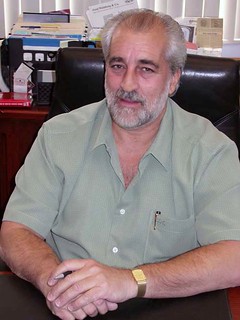 Greg Bennick: This is great. Three more quick questions if I could?
Greg Bennick: This is great. Three more quick questions if I could?
Fred Weinberg: Sure!
Greg Bennick: I was talking to David McCarthy recently and he mentioned the $4 Stella story.
Fred Weinberg: [laughs] Yeah, I'm known for that.
Greg Bennick: Just so we have it in one place for history's sake: would you be willing to tell the $4 Stella story?
Fred Weinberg: Sure! So, PCGS started in June of 1986, I believe. And I was one of the original 31 dealers that David Hall invited to participate and be one of the market makers. That summer, I had a good friend and customer who collected proof gold. I submitted for him his matte proof $2.5 Indians. He had a matte proof St Gaudens and he had a $4 Stella. He had a gem proof $2.5 Liberty and a gem proof $10 Liberty. And a Pan Pacific set. I mean, this guy was a major player.
I got a batch of those coins back from PCGS one day and they were put into the safe. I had started my
business the year before. This was maybe fall of 1986. The bank that I was the dealing with wanted to see my
operation because we were running a lot of money through the company. We kept on getting bigger and bigger
and making bigger deals and more money. So the banker came to the office, and he said, can you show me
some coins? I said, Sure.
I opened up the safe, and on a black rectangular tray, like a foot and a half long and 8 deep I probably had six
or seven, just back from PCGS, proof gold coins from my customer. I opened up the safe, with the banker in
my office. I took the tray to go walk into my office to show him these expensive coins, because you know, that
will impress him. And as I moved, my arm hit something in this vault room which served also as our shipping
room. The tray fell down on one of the shipping counters and I grabbed all the coins, put them back on the tray,
walked into the office and I showed him all these coins. This is a Saint worth $50,000, and this one's worth
$10,000,
and he was fascinated with all of it.
So that was a Friday afternoon. I did my dog and pony show and he left. I come back on Monday, open
up the safe a couple hours later, and I go to tell the customer who submitted the coins that his coins came
back and these are the PCGS grades. And as I'm looking at the tray there's all the coins except the Stella. I
think, Wait. Where the hell is the Stella?
So I had to strip the safe. We stripped the vault room. We checked the trash cans. We checked everywhere. The problem was, the trash gets picked up Friday night, and then Saturday morning it gets delivered to the Simi Valley trash dump, about 25, 30 miles north of my office where I am now. By the time we figured out what had happened - by Monday afternoon - and we called the building main office, and they called the trash people, it turns out that the trash that they had picked up Friday night was indeed delivered Saturday, but a lot of trash was dumped on Saturday. And there was Saturday, Sunday and Monday.
There was basically three days worth of trash. They said it's impossible. You'll never find the coin. And I
actually talked to somebody that worked there and they said, It's impossible, you'll never find it.
So that's basically the story. I lost it. I lost the Stella. At the time, the coin was worth fifty grand. So I owed my customer fifty grand, which I paid him. And that coin today as a 64 would probably be worth 150 grand. But it's probably a 65 or a 66, which means it would probably be worth about 200 or 250 grand today.
Greg Bennick: Wow. This is like the story of the guy who threw out the hard drive a year or two ago with all the Bitcoin information on it.
Fred Weinberg: Yes! Thank God for him, because until he did that, I was the biggest idiot for throwing away a $50,000 coin. [laughs] I'm happy that he lost $27 trillion dollars or something. That makes me look like I'm sane compared to him.
Greg Bennick: So you mentioned that learning the minting process was instrumental for the hobby to grow,
and probably speaks directly to a huge influx of people today saying, Hey, I've got this coin that is for sure an
error.
But they don't know the minting process, therefore they have no idea that their coin is or is not an error.
With the changes in minting techniques in the last 20 years, what's the best way for people – and for collectors
- to find out about new minting processes? I mean, do you think Arnie's ETCM and the magazines that he put
out decades ago are still relevant today?
Fred Weinberg: Yes, I think they are. Because if you think about it, the Schuler horizontal presses from 2000, give or take a year, every coin struck before that are struck on the older vertical presses. So Arnie's books or any deep information on the minting process, including, I think Amex did a couple of guidebooks, and I think the ANA did a couple of books for their summer seminars. That information is still valid because they were striking coins that way for 200 years before we went to these horizontal Schuler presses. So the minting process information is still very accurate. And I encourage people to get books, to read something online, to acquire a concept of how coins are struck. You still need to see real pictures, you still need to see real coins, you still need to go to your local coin shop and show them what you have and see what they have, and learn the difference between a scratch and a lamination, and a die crack and a scratch, and this and that, and gold plating. You need some hands-on experience. But there's a ton of information that's available today that was not available to me, or anybody 40 or 50 years ago. It's all out there.
Greg Bennick: What do you think the best way is for people readers, say, of this interview, to inspire a new
generation of collectors? I remember asking Arnie this many years ago and him telling me it was an uphill
battle because he felt that young people today
were more interested in dating than they were interested in
hobbies!
Fred Weinberg: What I try to do is this. I always keep a few coins at home or I keep a few coins in my briefcase when I go to coin shows. I'm constantly giving, whether it's an off-center penny or just some cheap regular coin that's worth a couple of dollars, something to any kid that comes up to me and expresses an interest in errors.
At the ANA last August for example, kids would come up and would look at my showcase of dramatic
errors. They'd say, Oh! Look at that!
They weren't quite sure what they were looking at. But I would ask them,
Do you collect coins?
And, How long have you collected coins?
If they replied that it was more than a day, I
had a little box, and I would say, You can pick two or three out of here for free.
And again, these coins had
little value, but the fact that you could give something to an 8 year old, or a 12 or a 15 year old kid for
free….that's how I like to motivate kids. And to tell them an interesting story or of course to answer their
questions about coins.
Greg Bennick: Is there anything that we missed talking about?
Fred Weinberg: Well, something that just popped in my head. I've been lucky enough to remember when we had the 1977 ANA in Atlanta, and Arnie pushed - and I did a little bit too, though it was mostly Arnie - we pushed to get the ANA to accept errors as its own exhibit category. That was a first in 1977. So, I'm happy that I participated in that. And I've seen the evolution of the error hobby over the decades, both with the clubs, the minting process itself, and the value of coins themselves.
I feel very happy and proud that I've been able to participate in this 50 year -- it's actually probably more -- it's probably about 62 years total that I've been doing this, since I was 9 or 10. I've just been thrilled that I've been able to see how the hobby has evolved and changed and expanded so much in the last 60 plus years.
Greg Bennick: Thank you so much for everything Fred. I really appreciate it. The whole hobby does as well.
Fred Weinberg: My pleasure!
Greg Bennick has been a wildly obsessed error collector since age twelve. He is the CONECA State Representative for Washington. He splits his time between Seattle and Portland and this is the first of many articles and interviews he has planned to share with Errorscope readers.
For more information about CONECA, see:
https://conecaonline.org/
To read the earlier articles in this series, see:
Fred Weinberg Interview, Part One
(https://www.coinbooks.org/v25/esylum_v25n28a15.html)
Fred Weinberg Interview, Part Two
(https://www.coinbooks.org/v25/esylum_v25n29a17.html)
Fred Weinberg Interview, Part Three
(https://www.coinbooks.org/v25/esylum_v25n30a15.html)
U.S. PAPER IN WORLD BANKNOTE AUCTIONS SALE 29
There are a number of U.S. offerings in World Banknote Auctions Live Sale 29. Here's an announcement of some of the U.S. highlights. -Editor
World Banknote Auctions has now launched Live Sale 29 at www.worldbanknoteauctions.com.
Live Sale 29 starts on August 4, 2022, with live bidding that day at 1 PM Eastern / 10 AM Pacific. Please note that Sale 29 is divided in two parts, each selling on a different day. The first live sale with 547 lots takes place on August 4 at 10 AM PST. The second timed sale with 471 lots opens on July 12 at 10 AM PST and closes on August 7 at 3 PM PST (special bidding rules apply for the timed sale, please see our website for details).
Below, you will find highlights from the American series, which includes a very nice selection of Confederate and Fractional currency, including very scarce varieties, and select high grade large size type notes.
Lot #29432: United States 1880 Fr. 107 PCGS Gem New 66 PPQ 10 Dollars Legal Tender Note
Lot #29433: United States 1901 Fr. 119 PCGS About UNC 55 10 Dollars Legal Tender Note
Lot #29434: United States 1923 Fr.123 PMG Choice Very Fine 35 10 Dollars Legal Tender Note
Lot #29435: United States 1891 Fr. 364 PMG Choice UNC 63 EPQ 5 Dollars Treasury Note
Lot #29473: United States Fr. 1379 PMG Gem UNC 66 EPQ 50 Cents Fourth Issue Fractional Currency
Lot #29476: Confederate States 1861 T-5 PMG About UNC 53 100 Dollars
Lot #29477: Confederate States 1861 T-6 PMG Choice About UNC 58 EPQ 50 Dollars
Lot #29482: Confederate States 1861 T-11 PMG Fine 12 NET 5 Dollars
Lot #29483: Confederate States 1861 T-12 PMG Very Fine 20 5 Dollars
Lot #29491: Confederate States 1861 T-23 PMG Very Fine 30 10 Dollars
For more information, see:
https://www.worldbanknoteauctions.com/
To read the earlier E-Sylum article, see:
WORLD BANKNOTE AUCTIONS SALE 29
(https://www.coinbooks.org/v25/esylum_v25n29a20.html)
STACK'S BOWERS PHYSICAL CRYPTOCURRENCY
In the bitcoin-of-a-different-color department is this press release from Stack's Bowers describing their upcoming sale of a colorful group of physical bitcoins and other cryptocurrency. -Editor
Stack's Bowers Galleries is thrilled to announce another unprecedented selection of Bitcoins and physical cryptocurrency in their Summer 2022 Global Showcase Auction. This offering comes on the heels of the firm's record-setting sales of Bitcoins in their April and June 2022 auctions, where strong premiums of up to 5000% were realized. Collector demand for physical cryptocurrency continues to grow among both crypto enthusiasts and traditional numismatists, and Stack's Bowers Galleries has positioned themselves as the clear leader in this new and exciting category. Their Summer 2022 sale features the popular Casascius, Satori, BTCC, and MoonBits series in a range of denominations from 0.001 Bitcoin to 5 Bitcoin, as well as several Fresh LTC 0.5 Litecoin pieces for collectors to pursue.
This selection is highlighted by an incredible 2012 Casascius 5 Bitcoin Bitnickel
that is one of only two examples
certified by PCGS. Graded MS-65, it is a rare issue with fewer than 500 loaded examples remaining and more
continuing to be redeemed each week.
Stack's Bowers Galleries is also delighted to present an extremely rare Double Error 2011 Casascius 1 Bitcoin
which represents one of the Holy Grails of the series. Specialist Elias Ahonen points out in his Encyclopedia that
overlooking the prototype gold coin, [the Double Error] is the rarest Casascius coin.
This specimen is one of just
five produced and it is likely that not all five remain loaded. Graded MS-66 (PCGS), it is a true trophy coin for the
advanced collectors of this series.
The historic 2011 Casascius CASACIUS ERROR
1 Bitcoin is represented by several MS-67 (PCGS) examples
that are tied for finest known of the issue. This issue is significant as the very first funded physical bitcoin ever
produced. An MS-66 (PCGS) specimen sold for $78,000 in the firm's April 2022 sale and even stronger premiums
are expected as collector interest continues to grow.
The Summer auction also represents the firm's debut of a silver example from the Casascius series, where a stunning 2013 Casascius 1 Bitcoin graded SP-69 (PCGS) will be presented. An incredibly impressive Redeemed 2011 Casascius 25 Bitcoin is also offered as a historic keepsake from this series. It is graded AU-58 (PCGS) and combines absolute rarity with a colorful history that includes educational demonstrations and use as actual currency.
In addition, fractional Satori, BTCC, and MoonBits offer attractive entry-points for collectors looking to dip a toe into this category, and offer a range of denominations from 0.001 to 0.5 Bitcoin. Seldom-seen examples from the Fresh LTC series also present collectors a rare opportunity to acquire this grassroots issue.
Featuring 42 lots in total, the Stack's Bowers Galleries Summer 2022 sale represents the largest offering of physical cryptocurrency ever presented in a live auction. These pieces will be sold at the end of the Rarities Night session which opens for live bidding on Thursday, August 25th at 2:00 PM PDT. Stack's Bowers Galleries is also excited to offer their clients the ability to pay for their purchases with Bitcoin. The firm has arranged with BitPay to facilitate all Bitcoin payments and a 1% fee will be added to all invoices for this service. Additional terms and conditions apply, and bidders are encouraged to contact Stack's Bowers Galleries before the sale with any questions relating to payment via BitPay. For questions on this offering of Bitcoins or to consign your physical cryptocurrency to a future auction, contact Stack's Bowers Galleries today at Consign@StacksBowers.com or 800-566-2580.
STEPHEN ALBUM INTERNET AUCTION 17
Here's the announcement for the August 2022 internet auction from Stephen Album Rare Coins. -Editor
Stephen Album Rare Coins will hold its Internet Auction 17 at its offices in Santa Rosa, California on August 8, 2022. Internet pre-bidding has already begun and can be accessed through their website. The Auction is made up of 675 lots of world coins, all certified by PCGS, including Chinese and Indian coins. Featured coins include a 1911(b) British India rupee in MS65 and a 1764-G Guatemala 2 reales in VF20. Estimates range from $35 to $1800. Sample lots from the sale follow:
LOT 664: INDIA: BRITISH INDIA: George V, 1910-1936, AR rupee, 1911(b), KM-523, S&W-8.15, scarce one-year type, a superb, toned example! PCGS graded MS65. The 1911 accession to the throne of Emperor George V led to the famous "pig rupee." On the coin, the King appeared wearing the chain of the Most Eminent Order of the Indian Empire. Because of poor engraving the elephant looked very much like a pig. The Muslim population was enraged, and the image had to be quickly redesigned. Estimated at $125-$175.
LOT 174: WORLD: GUATEMALA: Carlos III, 1759-1788, AR 2 reales, 1764-G, KM-25, Cal-549, PCGS graded VF20. Estimated at $75-$100.
LOT 189: WORLD: INDONESIA: Republic, AR 750 rupiah, 1970, KM-26, 25th Anniversary of Independence - Garuda Bird, with beautiful toning! PCGS graded Proof 67 DCAM. Estimated at $100- $150.
LOT 450: CHINA: REPUBLIC: AR dollar, ND (1927), Y-318a, L&M-49, Memento type, Sun Yat-sen, 6- pointed star, a lovely, toned mint state example! PCGS graded MS63. Estimated at $200-$300.
LOT 212: WORLD: IRAQ: Republic, AR dinar, 1977/AH1397, KM-143, Opening of Tharthar-Euphrates Canal, PCGS graded Proof 68 CAM. Estimated at $100-$150.
LOT 311: WORLD: PALESTINE: British Mandate, 20 mils, 1933, KM-5, scarce date in high quality and this is an attractive mint state example! PCGS graded MS62. Estimated at $150-$250.
LOT 280: WORLD: MEXICO: Republic, AR 8 reales, 1896-Zs, KM-377.13, assayer FZ, a wonderful, toned example! PCGS graded MS64. Estimated at $150-$250.
LOT 427: WORLD: VATICAN: Pius XI, 1922-1939, AV 100 lire, ND (1933-34), KM-19, Holy Year commemorative, a lovely lustrous example! PCGS graded MS63. Issued for the Christian Jubilee starting April 2, 1933, commemorating of the 19th century of the death of Jesus. Pope Pius XI was quoted in the New York Times on 25 December 1932, that the "common opinion of the faithful" identifies the year AD 33 with the death of Jesus Christ. Estimated at $500-$600.
LOT 469: CHINA: CHIHLI: Kuang Hsu, 1875-1908, AR dollar, Peiyang Arsenal mint, Tientsin, year 34 (1908), Y-73.2, L&M-465, cloud connected variety, cleaned, PCGS graded EF details. Estimated at $300- $500.
The firm is now taking consignments for future internet and premier sales. More information can be found on their website at www.stevealbum.com.
DAVISSON'S E-AUCTION 44
In an email to clients on July 28, 2022, Allan Davisson published this overview of his firm's upcoming sale, reflecting on the lessons available from centuries of coinage. -Editor
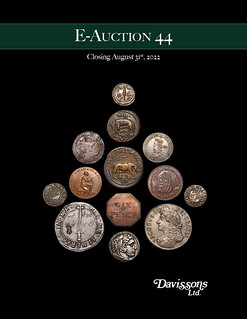 E-Auction 44, closing Wednesday, August 31st 2022, is online now! Print copies are being sent today, if you are not on our mailing list and would like a copy please let us know.
E-Auction 44, closing Wednesday, August 31st 2022, is online now! Print copies are being sent today, if you are not on our mailing list and would like a copy please let us know.
Exchange, making change, storing value—if one wants a simple definition of what coins are for, this comes close. In ancient times gold was highly valued and sought after and was an important metal for trade. But trading with gold was a complex process. Traders in gold had to have balance scales when calculating payment. But weight alone was not adequate. Purity was a critical issue too. Traders had to have a touchstone—a black stone like jasper—as well as sets of touch needles. The bit of gold offered in trade was rubbed on the touchstone and the scrape was compared to a needle from a set. A ring of needles typically had 24 needles ranging from one part gold to 23 parts of the alloy all the way to a needle of pure gold. Traders had three sets of needles—gold and copper, gold and silver and gold combined with the other two metals.
The Lydians are credited with first marking lumps of electrum that had been tested. Electrum was a naturally occurring combination of gold and silver found in river beds and Lydian traders began marking the lumps that had been tested so that the process would not have to be repeated. Croesus, the last of the Lydian dynasts, is credited with standardizing these lumps somewhere around 550 B.C.E. His pieces were created to a standard so that values of each were equal. It took little time for this concept to spread and soon Greek cities adopted standards and began issuing coins.
We are still not that far removed from Croesus' idea. While we have expanded the meaning of money and we can make exchanges without physical coins, the US Mint still produces nearly 15 billion coins per year.
In looking over everything we are offering in this catalog I began thinking about the evolution of coins and coin manufacture—from hand struck bits of metal to machine struck, pretty much little more than a two-stage process of development. The catalog begins with some gold with an emphasis on late 19th century Europe (plus a bit more). For ancient Greece, there are some appealing silver pieces like the wrestlers of Aspendos, some tetradrachms from Seleukos I, one of the successors who took over part of Alexander the Great's kingdom, a shekel of Tyre, as well as a run of Greek bronzes—simpler coins more likely to be used in the daily lives of the average citizen.
Roman coins were closely tied to the ruler who issued them. The emperor's image on the obverse and a message or even a bit of propaganda on the reverse tied this coinage to an individual while Greek coinage was more often tied to a place. Greek bronze and the Imperial Greek bronze that reflected Roman control of Greek places was the common person's currency and it was used at the time and not generally preserved or treated well by the centuries.
This set of coinage standards and purposes continued and carried through after the Romans, and coinage as an exchange and as a store of value continued little changed on a fundamental level until the emergence of modern banking. It is this history that is presented in most of our catalogs—bits and pieces from all these eras. And we also offer offshoots—tokens that began as private efforts to create means of exchange when the government failed to mint enough coins, chunks of new world silver stamped with the names of Spanish kings, trade coins designed for use outside the countries of origin….
While working on this catalog, this spring and summer we have also been cataloging a major collection that has one of the most comprehensive collections of Anglo-Saxon coins we have handled. (Look for an introductory section in our next E-Auction and it will anchor our major early 2023 feature auction.) While I have been particularly impressed with this group of thrymsas and sceats and pennies, I have also been fascinated by the range of other things this advanced collector pursued. He and I used to talk about coins and collecting and fascination with the breadth of what numismatics offers. There is a certain satisfaction in building a focused collection but there is also a satisfaction in exploring the variety of intriguing coins that mankind has produced through history.
This catalog offers a wide range of things along with some consignments that have a specific focus—a collection of English sixpences, the first section of a collection of English crowns and US dollars, a small collection of British silver tokens from the 1811-1812 series, a few rare Scottish farthings along with many high grade 18th century tokens, a few Spanish American pieces including a couple of pieces from Carlos and Johanna and the 16th century, and more.
For me, one of the great pleasures of handling material consigned to us is the opportunity to learn something new and even to buy a new book or two exploring a new path.
For more information, see:
https://davcoin.com/
THE BOOK BAZARRE
S.S. CENTRAL AMERICA ARTIFACTS EXHIBITED
Artifacts from the fabled wreck of the S.S. Central America were on display in Reno this week. Here's an article from the Reno Gazette Journal. -Editor
A mysterious daguerreotype of a woman and a pair of jeans possibly made by Levi Strauss himself are among nearly 1,000 Gold Rush-era treasures recovered from the fabled "Ship of Gold" that will be on display in Reno this week.
Since their recovery between the late 1980s and 2014, the remarkable findings extracted from the sunken S.S. Central America have been in secret storage, but this week begins a national tour, which will start at the National Antique Bottle Convention from July 28 through 31 at the Grand Sierra Resort in Reno.
This is the first public exhibition of the artifacts, which will be auctioned off later this year.
Among the notable recovered items are the lid to the oldest known Wells Fargo treasure shipment box; 1857 clothing, including a pair of the earliest known Gold Rush-era canvas work pants jeans with a button fly that may have been made by Strauss in his early years in business; and jewelry made from California Gold Rush "mother lode" native gold in quartz as gemstones, according to Fred Holabird, president of Holabird Western Americana Collections in Reno.
There is even a key to the ship's wine storage room and an S.S. Central America brass name tag attached to a set of keys that belonged to the ship's purser. We believe these were for the locked room where the gold treasure cargo was kept,
Holabird said in a press release.
Other items recovered include pistols; brass luggage tags; passengers' ticket receipts; galley utensils and dishes; ornate, flint glass wine and spirits decanters that appear to have been a standard amenity in the first-class staterooms; eyeglasses in solid gold frames; and chewing tobacco in a pouch apparently from the 1851 London World's Fair, Holabird said.
While laden with booty, the S.S. Central America shipwreck was also a deep sea gravesite.
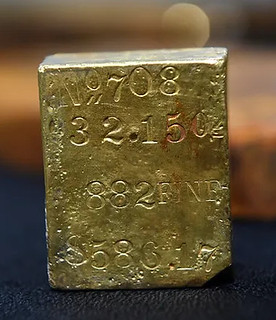 The ship sank 7,200 feet deep in the Atlantic Ocean off the North Carolina coast during a hurricane on September 12, 1857. The ship was on a voyage from Panama to New York carrying tons of California Gold Rush coins, ingots, and gold dust from the San Francisco and Northern California area.
The ship sank 7,200 feet deep in the Atlantic Ocean off the North Carolina coast during a hurricane on September 12, 1857. The ship was on a voyage from Panama to New York carrying tons of California Gold Rush coins, ingots, and gold dust from the San Francisco and Northern California area.
The items on display during the upcoming convention were kept in storage in three different states: Maryland, Massachusetts, and Ohio, until a court-approved settlement was reached ending a decades-long ownership dispute.
Scientist Bob Evans, who was on each of the recovery missions, will be at the exhibit in Reno to talk to visitors about the Ship of Gold
and the recovered Gold Rush artifacts.
The items will be offered in public auctions in October and November by Holabird Western Americana Collections. Currently, California Gold Marketing Group of Brea, Calif. owns the antiques.
Check out the full article online, which includes a nice video with Bob Evans. -Editor
To read the complete article, see:
Treasures from 1857 'Ship of Gold' shipwreck unveiled in Reno
(https://www.rgj.com/story/news/2022/07/27/treasures-1857-ship-gold-shipwreck-unveiled-reno/10158916002/)
Arthur Shippee passed along a USA Today article with exhibit tour information and a great gallery of 24 photos - check it out. Thanks. -Editor
The first display will be Friday through Sunday at the National Antique Bottle Convention in Reno, Nevada. The artifacts will then be at the Chicago World's Fair of Money in Rosemont, Illinois from Aug. 16-20 before heading to the HardRock Summit 2022 Gem and Jewelry Show in Denver from Sept. 8-11.
All the items will be up for auction in October and November, though exact dates haven't been announced. Keep an eye on the auction website for more details.
To read the complete article, see:
175 years after it sank, 'Ship of Gold' treasures begin tour of US before going up for auction
(https://www.usatoday.com/story/news/nation/2022/07/29/ss-central-america-shipwreck-artifacts-treasure/10153502002/)
Fred Holabird provided this image of the exhibit, showing about one third of the total area. -Editor
Bob Evans provided this report and images from the show. Thanks!
"The show in Reno is great! Fred Holabird and his company have put together a fabulous display of non-numismatic artifacts from the Central America. It is wonderful to bring these artifacts to the public and to see their reaction. We have a wide variety including jewelry, bottles and ceramics, wooden treasure boxes, including the lid from a Wells Fargo box, and clothing from the recovered trunks. I am really looking forward to bringing this and even more, including the robot submarine Nemo, to the ANA convention in Rosemont in a couple weeks, to share with all my numismatic friends and the general public. Numismatists currently know the SS Central America story better than any other collecting community, and now they can see the rest of the story and learn the tales these artifacts have to tell. It will be great! See you there!"
Another article has some more images. -Editor
To read the complete article, see:
Sunken treasure artifacts from the S.S. Central America (1857) will be displayed, then auctioned
(https://www.artfixdaily.com/artwire/release/1328-sunken-treasure-artifacts-from-the-ss-central-america-(1857)-will)
NUMISMATIC NUGGETS: JULY 31, 2022
Here's a selection of interesting or unusual items I came across in the marketplace this week. Tell us what you think of some of these. -Editor
PCGS 1793 wreath cent vine & bars edge S-11a. The coin is struck 10% off-center. A lot of planchet is visible and also portions of the rim detail and lettering is missing, making this a visually obvious off center strike.
The first year for striking cents at a U.S. Mint, the coin is special in this regard and also because off-center struck 1793 cents are rare, with an estimated 2-4 known. This is only the 2nd example we have actually seen. The coin can be traced back to the Neiswinter Collection.
An opportunity to buy the first U.S. Mint issued cent and an error--proof they've been making mistakes since the first year they began minting cents!
VF details with some damage. There are some old, toned over nicks on the obverse, and the surfaces show some porosity. Overall a nice coin for its age.
Wow! What a great coin. Is this the earliest known error from the U.S. Mint? Does anyone own one of the other examples? From the online stock of new E-Sylum supporter Jon Sullivan. -Editor
To read the complete lot description, see:
pcgs 1c 1793 flowing hair wreath cent struck 10% off-center vf
(https://www.sullivannumismatics.com/coin/pcgs-1c-1793-flowing-hair-wreath-cent-struck-10-center-vf?v=8201)
1885 Shepard Hardware, NY, when the lever is pressed the girl drops a coin from the pan into a box while the dog wags its tail and open its mouth. In this bank the trap door of the box is stuck downward and the dog lacks mobility of any kind.
6 3/4 x 7 x 3 in.
From the Estate of the late Dr. & Mrs. George A. Engstrom, Concord, North Carolina
Not functioning as made; paint losses.
A cool cast iron coin bank. -Editor
To read the complete lot description, see:
Cast Iron Mechanical Bank, Girl and Her Dog
(https://www.lelandlittle.com/items/456907/cast-iron-mechanical-bank-girl-and-her-dog/)
ARCHAEOLOGISTS FIND RARE ZODIAC COIN
David Pickup passed along this Haaretz article about the find of a rare "zodiac" coin. -Editor
A beautiful bronze coin almost 2,000 years old has been rescued from the depths of the Mediterranean off Israel during an underwater archaeological survey, the Israel Antiquities Authority announced on Monday. The coin shows the emperor on one side, as befits coinage of the time, and Cancer, the crab sign of the zodiac and a lady on the other – interpreted as the moon goddess Luna.
The crab coin bears the date Year eight,
referring to the eighth year of rule by the Roman Emperor Titus Aelius Hadrianus Antoninus Pius. That eighth year was either 144 or 145. It belongs to a series of 13 coins, one for each sign of the zodiac and one the complete zodiac wheel, the IAA said.
Cancer is Latin for crab
and that is why it is named thusly in horoscopes. The weekly reading for Cancerians, courtesy of India TV: Cancer should avoid investment plans.
EliteDaily elaborates: As the week kicks off, Venus in Cancer will square Jupiter in Aries
– and that's just the beginning of that astrological analysis.
Scholars think that astrology, the pseudoscience of mundane divination, may have originated in Sumeria around 5,000 years ago, though there is clearer evidence for early zodiac belief in Babylon almost 4,000 years ago. Others suspect the belief originated in China, or ancient Egypt or Greece; maybe astrology spontaneously developed, much like agriculture, in different places at different times for different reasons.
Back to the coin, which clearly shows the crab: its arthropodan eyes on stalks, the right number of legs, its pincers in position seemingly holding up a half-crescent, above which we see the profile of Luna, and a star.
The other side shows the profile of the Gaul-born Emperor Antoninus Pius, one of the so-called five good emperors
who did not pursue military glory and booty but ruled in peace, which may explain the paucity of historical records from his reign. He did put down a rebellion in Britain, but is better remembered for his encouragement of culture through building temples and theaters – and promoting science, which has not found support for astrology in any way.
To read the complete article, see:
Diving Archaeologists Find Rare Zodiac Coin on Mediterranean Seabed by Israel
(https://www.haaretz.com/archaeology/2022-07-26/ty-article/diving-archaeologists-find-rare-zodiac-coin-mediterranean-by-israel/00000182-3441-db9c-a5a2-fe4b6ae50000)
Thanks also to Aaron Oppenheim, Arthur Shippee, Howard Berlin, Peter Huntoon and others for passing along related articles. -Editor
To read the complete articles, see:
1,877-year-old bronze Roman coin discovered on Israeli beach
(https://www.jpost.com/archaeology/article-713002)
Bronze coin dating back nearly 2,000 years found on Israeli beach
(https://www.i24news.tv/en/news/israel/archeology/1658758287-bronze-coin-dating-back-nearly-2-000-years-found-on-israeli-beach)
SPANISH GALLEON MARAVILLAS FOUND
Coins aren't mentioned in this Guardian article, but the image of artifacts recovered from the wreck of the Nuestra Señora de las Maravillas shows gold, jewellery and coins. -Editor
It was a Spanish galleon laden with treasures so sumptuous that its sinking in the Bahamas in 1656 sparked repeated salvage attempts over the next 350 years. So when another expedition was launched recently, few thought that there could be anything left – but exquisite, jewel-encrusted pendants and gold chains are among spectacular finds that have now been recovered, having lain untouched on the seabed for hundreds of years.
The Nuestra Señora de las Maravillas (Our Lady of Wonders) went down on the western side of the Little Bahama Bank, over 70km offshore, but the newly discovered treasures were found across a vast debris trail spanning more than 13km.
Allen Exploration, with Bahamian and US marine archaeologists and divers, was licensed by the Bahamian government to explore the Maravillas scientifically and is committed to displaying the finds in a new museum in the Bahamas.
An elaborate, gold filigree chain, with rosette motifs, is among treasures that suggest some of the discoveries were destined for wealthy aristocrats, if not royalty. A gold pendant bearing the Cross of Santiago (St James) and an Indian bezoar stone, then valued in Europe for its healing properties, is shaped like a scallop shell, the symbol recognised by pilgrims heading for Santiago de Compostela in Galicia. It is among finds linked to the sacred Order of Santiago, a military-religious order of knights, who protected pilgrims and were active in Spain's maritime trade. Another pendant features a gold Cross of St. JamesSantiago over a large, green, oval emerald framed by a dozen square emeralds, perhaps symbolising the 12 apostles.
Clusters of emeralds and amethysts mined in Colombia and now recovered offer evidence of contraband trafficking as they were not registered on the manifest.
Dr Sean Kingsley, an English marine archaeologist and editor of
Wreckwatch magazine which will feature the finds in a forthcoming issue, told the Observer that such marvels
are particularly dramatic as they were in the middle of nowhere, under dense sand. This is successful key-hole archaeological surgery,
he said.
The expedition is also collecting data on the reef health, seafloor geology and plastic pollution to understand how the archaeology and marine environment interact.
The sea bottom is barren,
said Allen. The colourful coral that divers remembered from the 70s is gone, poisoned by ocean acidification and choked by metres of shifting sand. It's painfully sad. Still lying on those dead grey reefs, though, are sparkling finds.
To read the complete article, see:
After 350 years, sea gives up lost jewels of Spanish shipwreck
(https://www.theguardian.com/science/2022/jul/31/after-350-years-sea-gives-up-lost-jewels-of-spanish-shipwreck)
FRENCH COINS IN AMERICA
Jérôme Jambu published an American Numismatic Society Pocket Change blog article titled French Coins in America or French American Coins? (and which America?). Here's an excerpt - see the complete article online. -Editor
As American numismatists and collectors of the colonial period know, it is difficult to differentiate coins of the Kingdom of France sent to America from those produced specifically for this region. It is equally difficult to name these coins, to determine their value, and to attribute them to a specific place. There are two reasons for this: the difficult access of Americans to archives written in French, scattered throughout the country; and the little interest shown by the French people, a large part of whom have forgotten their history in the New World. However, the cross-referencing of available data is necessary to understand these coins and reclassify them, as Sydney F. Martin began (Martin 2015) one hundred years after Ernest Zay (Zay 1892).
A couple of examples can illustrate this problem. First, for more than 300 years, French, Canadian, and American numismatists gave the 5- and 15-sol Gloriam Regni
coins (Fig. 1), struck in 1670, to New France
(and particularly to Canada) because of an error of attribution by Le Blanc in 1690, always repeated without being interrogated. Although some of these coins had effectively circulated in this area, we are today sure due to the recent discovery of unpublished French documents, that they were created specifically for the French West Indies (Jambu 2021).
Figure 1. 15-sol Gloriam Regni,
1670, Paris, created for French West Indies
(ANS 1967.99.1, where it was classified as Canadian until recently).
The sou
or sol marqué
reflects another problem. This designation includes a variety of different coins. In France, the nickname marqué
was attributed to sols reformed with a countermark in 1640. It was used in the French colonies and today by Americans for several types of sols: those countermarked in 1640, some without countermark, the series produced between 1738 and 1764 (Fig. 2), etc. Furthermore, not one of these coins were created especially for French America—not even the sols reformed in 1640 and those created in 1738, contrary to the opinion expressed by some authors on both sides on the Atlantic. They have just been sent to the colonies, when necessary, like so many other coins. French coins in America are not French American coins.
Figure 2. Sol marqué
, 1740, Rouen, created for the French Kingdom
(ANS 1967.99.21, where it was classified as Canadian until recently)
French coins made specifically for American colonies are in truth very few. They are only small coins. The 5- and 15-sol coins dated 1670 were the first in silver, followed only by the 6- and 12-sol coins dated 1731–1732. These second ones clearly show through their legend, Isles du Vent
(Windward Islands), they were made for the Lesser West Indies (Fig. 4). Like the previous issue, these were used to break the high-valued piastres with a too-strong purchasing power, and which circulated in abundance. Even though, once again, they may have migrated to other areas, especially because the monarchy had given them a too low price (Jambu forthcoming).
Three other creations are related to copper small change—and they were hardly successful. The 6- and 12-denier coins for the colonies
were not made for a long time in Perpignan (1717), due to insufficient material and poor-quality metal. A few were shipped to the continent, in New France. The 9-denier Colonies françoises
coins, minted in La Rochelle and Rouen in 1721–1722, are one part of a larger program (Fig. 5): denominations of 4½ and 18 deniers were imagined, as well as produced in Bordeaux and La Rochelle. Canada accepted a few of them, though with distrust. Only Louisiana welcomed them before finally returning some to France a few years later. They were better received in the thirteen British North American colonies…and subsequently in the Indian Ocean French colonies! Finally, the Colonies françoises
copper coins from 1767, despite their vague legend, were only intended for Lesser West Indies and immediately refused. Martinique charged them on ships going to France, and Guadeloupe stored these coins, only to counterstamp and use them during the Revolution (1793). Copper coins did not successfully circulate in the Caribbean area, which was accustomed to precious metals, and the continent could hardly be satisfied with it. To understand this, one must keep in mind that French people were particularly mercantilist and bullionist, and abhorred any kind of fiat money, as the State had abused paper money (bills from the Bank of Law in France, card money in Canada).
Figure 5. 9-denier Colonies françoises
, 1721, Rouen, created for New France
(ANS 1966.252.17, where it was classified as Canadian until recently)
To read the complete article, see:
French Coins in America or French American Coins? (and which America?)
(https://numismatics.org/pocketchange/jambu/)
ZIMBABWE INTRODUCES GOLD COINS
Zimbabwe's Reserve Bank has introduced gold coins. What's really going on here? Is this a product meant to bring in foreign profits? How would it do anything to help poor Zimbabwe citizens? -Editor
The Reserve Bank of Zimbabwe Governor John Mangudya on Monday unveiled gold coins that are expected to act as a store of value and reduce the demand for U.S. dollars as the country battles to control soaring inflation. "The Bank has today released the first batch of 2,000 Mosi-oa-Tunya (The Smoke Which Thunders) gold coins to the market. Local agencies commenced selling the gold coins on an agency basis at the initial price of 1,823.83 U.S. dollars per gold coin or 805,745.35 Zimbabwean dollars using the willing buyer willing seller selling rate as at Friday," Mangudya told a press conference in Harare, the capital of Zimbabwe.
Among other characteristics, the gold coin will have liquid asset status, prescribed asset status, can be used as collateral, is tradable and can be bought back at the instance of the holder.
Individuals, domestic corporates including institutional investors will be allowed to buy the gold coins in local currency as well as foreign currency, while international buyers will only buy the coins in foreign currencies which include the U.S. dollar, South African Rand, and British Pound among others.
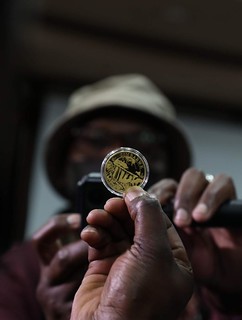 The price of the coin is based on the prevailing international price of gold plus 5 percent to cover the cost of production and distribution of the coin on a payment versus delivery basis.
The price of the coin is based on the prevailing international price of gold plus 5 percent to cover the cost of production and distribution of the coin on a payment versus delivery basis.
"The gold coins as we have advised before, are a good alternative investment product for those who want to store value. Gold is a safe and secure reserve asset throughout the world," said Mangudya.
The introduction of the gold coins is part of the government's measures to tackle the country's currency crisis which has seen the local dollar rapidly depreciating.
Following years of hyperinflation, Zimbabwe abandoned its own currency dollar in 2009, opting instead to use foreign currencies, mostly the U.S. dollar.
The government reintroduced the local currency in 2019, but it has rapidly lost value, bringing back memories of a period of hyperinflation which eroded many people's savings.
To read the complete article, see:
Zimbabwe's central bank introduces gold coins as store of value amid high inflation
(https://english.news.cn/20220727/7f36c559cd83458aae1d01f913665316/c.html)
The coin image is from this Bloomberg article:
Zimbabwe Gives Images of Gold Coins Meant to Tackle Inflation
(https://www.bloomberg.com/news/articles/2022-07-22/zimbabwe-gives-images-of-gold-coins-meant-to-tackle-inflation)
ONE POUND BULLION COINS
Speaking of bullion coins, Wayne Pearson submitted these thoughts on possible U.S. bullion coins. Thanks. -Editor
Canada and Australia have issued huge sized bullion coins with diameters similar in size to 100 pound weight plates for barbells, and as big as tires for some farming equipment.
That is a lot of bullion to be put in one place and something the average person couldn't afford.
And there were musings about issuing a trillion dollar platinum coin.
However, the trillion dollar idea prompted me to come up with another idea.
The gold and silver bullion program was started with the idea of paying down the NATIONAL DEBT.
Honestly, I don't know if there is enough bullion in the world to pay off all of our debt.
My idea is not to waste bullion in huge sizes but to offer a smaller version in ONE POUND sizes.
Gold and silver examples shown.
These coins will purposely be over priced because the intent is to raise money for the national debt. Even if only the rich can afford them.
A coin like Canada issued with 100KG of gold, could be better handled by selling smaller one pound versions and charging a lot more than the price of 12 one ounce coins.
Links:
https://www.dw.com/en/berlin-museum-director-responds-to-shocking-giant-coin-theft/a-38213691
https://www.cointalk.com/threads/australia-unveils-55-million-gold-coin.253143/
https://www.dailymail.co.uk/news/article-10065319/Biden-mint-trillion-dollar-coin-minute-Janet-Yellen-invokes-option-debt.html
https://www.usmint.gov/news/ccac-meetings/american-eagle-proof-and-bullion-silver-coin-reverse
https://www.usmint.gov/coins/coin-medal-programs/american-eagle/gold-proof
THE BOOK BAZARRE
R.S. Yeoman and His Remarkable Red Book,also tells the history of Whitman Publishing as well as his own unique life story in and out of numismatics. Enjoy more than 100 years of fascinating numismatic history in 352 richly illustrated pages, 8.5 x 11 inches, hardcover. Order your copy online at Whitman.com , or call 1-800-546-2995.
THE INC 2022 CONGRESS MEDAL
The 2022 International Numismatic Congress (INC 2022) will take place in September in Warsaw, Poland. A great medal has been designed for attendees. -Editor
Struck, silver plated with some gilding (as noted below), diameter 70 mm.
Obverse:
- at centre, logo of the XVI International Numismatic Conference;
- above, in the background, an element of the Royal Castle in Warsaw;
- below, selected Polish coins: (from left) Cracow groschen of Casimir III the Great; Glogau groschen of Sigismundus I the Old, 100 Polish zloty from 1925 (gilt); 10 ducats of Sigismundus III Vasa, Riga (gilt); obverse and reverse of a PRINCES POLONIE denar of Boleslaw Chrobry
Reverse:
- Stylised hands holding 100 ducats of Sigismundus III Vasa issued in 1621 (gilt)
- Legend around:
below, POLAND 11-16.IX.2022.
The number of medals is limited. Sale on a first-come, first-served basis
The medals will be available for personal pick-up during the Congress. Optionally after the Congress, courier delivery possibility on request at additional fee.
Round, two-sided medal, diameter 70 mm and thickness c. 4 mm, in two versions of alloy:
1. Brass (M90) silvered and oxidated, selectively gilded – price 200 EUR 2. Silver (Ag925) oxidated, selectively gilded – price 700 EUR
For more information on the Congress and medal, see:
https://inc2022.pl/
The Official Congress Medal
(https://inc2022.pl/congress_medal/)
UPDATE: THE CURRENCY BY DAMIEN HIRST
Here's a follow-up article Damien Hirst's project, The Currency. -Editor
Damien Hirst's NFT project The Currency
has come to an end, an experiment that explored the dynamics of art in Web3. As a result, collectors were left with a decision of whether they wanted to burn the NFT for a physical work of art or have the physical art burned and maintain ownership of the digital asset.
The decision by collectors came down to nearly a 50% split, meaning Hirst will have to burn close to 5,000 physical works of art — this includes 1,000 pieces owned by the artist himself, in a decision to burn 100% of his own physical works and keep all as NFTs.
A total of 5,149 NFTs were exchanged for their physical counterparts, meaning that the NFT version of the works is now slightly more scarce.
Inspired by bank notes, each physical work is handmade and started with a specially made piece of paper that features a watermark of Hirt's head. The works also include unique handwritten titles like I know you're going to sell me,
and a hologram, signature, and micro dot for proof of authenticity.
The Currency was the artist's first-ever NFT project and launched in July during what was the peak of the NFT market. The works that made up the collection were created in 2016 and then minted to the blockchain in partnership with HENI and Palm.
The burning of NFTs in exchange for a physical good or alternate perk is not unheard-of in the space, however, the burning of a physical of significant value in order to keep the NFT is a concept pioneered by Hirst.
Designed to explore the boundaries of art and currency, the project first went on sale for a mint price of roughly $2,000 USD. At the time of writing the floor price for the NFT works now sits at 5.6 ETH (approximately $9,000 USD).
Since The Currency, Hirst has launched another collection inspired by the art he did for Drake's Certified Lover Boy album cover in November — the second collection was distributed as an airdrop to holders of The Currency NFT.
To read the complete article, see:
Damien Hirst To Burn Thousands of Physical Works for NFT Project
(https://hypebeast.com/2022/7/damien-hirst-burns-nft-art-the-currency)
To read the earlier E-Sylum articles, see:
THE CURRENCY BY DAMIEN HIRST
(https://www.coinbooks.org/v24/esylum_v24n32a30.html)
SALES OF THE CURRENCY BY DAMIEN HIRST
(https://www.coinbooks.org/v24/esylum_v24n36a29.html)

